
















How the city’s response to the migrant surge, illegal short-term rentals is helping businessBy C. J. Hughes
e hotel industry’s post-Covid revenue rebound has been a marker of success in the city’s pandemic recovery.
It also may be misleading.
e notable improvement in the hotel sector’s fortunes over the past year seems to have more to do with government interventions than any major market turnaround, some hotel executives, developers and brokers say.
Indeed, e orts to grapple with issues including the migrant surge and illegal short-term rentals, such as units listed on Airbnb and other platforms that violate housing codes, have removed tens of thousands of rooms from the market, essentially propping up the lodgings that remain, notably hotel rooms, many of which have raised their rates to take advantage.
But even with those market-manipulating actions and a rebound in tourism, they say, hotel occupancy rates are still hovering below preCovid levels.


“A con uence of circumstances has pulled the sector out of the doldrums,” said Ronald Cohen, a broker with the rm Besen Partners who handles hotel deals. “But the reason for this Cinderella story has a lot to do with arti cial supply constraints.”



ough the city’s crackdown on improper short-term rentals seems potentially transformative for hotels, essentially kicking a

Nearly three weeks late, New York state lawmakers passed a new budget on April 20 full of signi cant new policies on housing, health care, transportation, cannabis and more.
e $237 billion spending plan contains a number of wins for Gov. Kathy Hochul, who persuaded leaders of the state Senate and Assembly to sign onto most of her top priorities — most notably a wide-ranging
housing deal, which fell into place thanks partly to Hochul’s concessions on tenant protections. On the other hand, the $4 billion growth in spending compared to Hochul’s initial budget plan re ects the Legislature’s success in rejecting some of her proposed cost-saving measures on Medicaid and public school funding.
e budget also delivers much-needed help for Mayor Eric Adams, who hoped desperately for measures to spur housing growth, cover the city’s migrant crisis costs
and preserve his control over city schools. All made it into the budget, in some form.
Here’s a partial list of the most notable policies.
Budget documents published on April 20 include the middlingly received housing deal containing a new tax break for

State nixes fare-free buses, boosts express service ahead of congestion pricing.
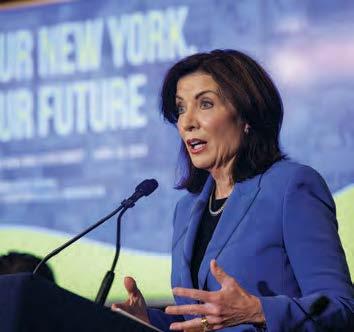

State contracts for three major o shore wind farms recently fell apart because a turbine manufacturer scaled back plans to build equipment the projects relied on. e cancellations underscore the supply chain pressures that plague the nascent industry.
e New York State Energy Research and Development Authority announced on April 19 that it could not reach a nal deal with three oshore wind projects: Attentive Energy One, Community O shore Wind and Excelsior Wind. In October, NYSERDA had provisionally awarded the contracts to the developments.
commercial complexities between provisional awardees and their partners, resulting in the provisionally awarded parties’ inability to come to terms,” NYSERDA wrote in a April 19 announcement.
e decision is an undeniable blow to New York’s ambition to generate 70% of its electricity from renewable sources by 2030 and create billions of dollars in economic development to grow the city and state’s green economy.
O shore wind is critical for New York to hit its renewable energy targets, including nine gigawatts of o shore wind by 2035; the April 19 decision left New York with just 1.7 gigawatts of o shore wind projects in the pipeline.
“Together, these projects represented close to ve gigawatts of offshore wind, so I’m not going to sugarcoat it, at a minimum it will result in some delay.”
All three e orts planned to rely on massive new turbines built by General Electric Vernova, but in February the Massachusetts-based company said that it would downsize its plans to a smaller model. e change “caused technical and

Join us for networking, dealmaking, and a live interview with New York City Planning Director, Dan Gardonick, the architect of the ambitious City of Yes initiative to modernize zoning regulations to support small businesses, create affordable housing and promote sustainability. Gardonick will discuss the details, timing, opportunities, and potential economic impact in a conversation with Crain’s New York Editor-in-Chief Cory Schouten.
“It’s obviously a setback,” said Fred Zalcman, director of the New York O shore Wind Alliance. “Together, these projects represented close to ve gigawatts of o shore wind, so I’m not going to sugarcoat it, at a minimum it will result in some delay.”
Zalcman pointed to “some important lessons to be learned” from the state’s latest solicitation for o shore wind projects, namely, that the state energy authority should look to “decouple its procurement of o shore wind facilities from its play for manufacturing.”
For instance, the developers behind the three projects decided to make GE Vernova’s supersize turbines integral to their projects after the company said — three days before project bids were due to New York — that it had submitted plans to build two new upstate factories if the company received su cient orders from the developers that were bidding.
As a result, New York in October provisionally awarded GE Vernova
and LM Wind Power $300 million in state funds to build the upstate manufacturing facilities. GE Vernova is now pivoting away from a hulking 18-megawatt turbine platform in favor of a smaller, 15.5- to 16.5-megawatt version. NYSERDA said the grant dollars will be made available in future solicitations.
“ ose procurements were just so intertwined that it creates enormous leverage for the suppliers but also creates enormous risks for project developers,” said Zalcman.
Andrew Doba, a spokesperson for Vineyard O shore, the developer behind Excelsior Wind, said in a statement that New York’s decision to back out of the contracts was “warranted given GE Vernova’s failure to follow through on their commitment to deliver an 18MW machine.”
GE Vernova, meanwhile, said the company is committed to working with its public and private partners to support New York’s o shore wind future.
Bigger isn’t always better
e philosophy behind the giant turbines is that larger equipment would deliver greater power at reduced costs. But the enormous equipment comes with equally extensive requirements. More port space is needed for assembly, and bigger boats are required to transport them.
Morten Dyrholm, an executive at one of GE Vernova’s competitor’s, Vestas Wind Systems, said during an April 16 panel discussion at the BloombergNEF Summit in New York that the turbine industry is “stuck in a technology arms race” to continually push out bigger and better products. at competition, he said, has added pressure on an already-delicate supply chain.
“It’s really time to industrialize and standardize our supply chains

and our products,” said Dyrholm. “If we were to go out tomorrow and change [our suppliers’] entire setup, that adds costs and adds time and complexity, and that’s not what we need right now.”
Atin Jain, a BloombergNEF analyst who focuses on o shore wind, said using lower-capacity turbines means that each developer would need to buy more than a dozen additional turbines to build a project of the same capacity. It also means a slew of other mounting costs to erect new foundations, additional cables, more days of hiring specialized installation vessels and so on.
“In the absence of a tari adjustment, developers’ pro t expectations would have su ered,” Jain said in an email. at said, Jain noted that Gov. Kathy Hochul’s administration has raced in recent months to head o contractual challenges faced by NYSERDA’s two surviving o shore wind projects, Ørsted’s Sunrise Wind and Equinor’s Empire Wind 1, and said a similar situation could unfold in the coming weeks.
On April 23, Hochul sought to again bolster con dence by announcing the launch of a $200 million “Supportive Manufacturing and Logistics Request for Proposals” to support infrastructure investments in the o shore wind supply chain. e state also said it will soon issue a request for information to inform New York’s fth o shore wind farm solicitation, along with the design of a $300 million request for proposals for “major component o shore wind supply chain investments,” such as turbines.
Jeremy McDiarmid, managing director and general counsel at Advanced Energy United, an advocacy organization, described the setback as “very typical for construction projects of this size, particularly with the lasting impacts the pandemic had on supply chains, nancing, and leasing.”
“When a building construction project doesn’t move forward, we don’t treat it as an indictment of the building construction industry,” McDiarmid added, “and it should be the same for o shore wind.”
e city is getting a rare project with more than 100 residential units in the South Bronx.
e site is at 1848 Vyse Ave., just below the Cross Bronx Expressway by East 176th Street, and comes from Dunn Development, a real estate rm based in Gowanus. It will span just over 90,000 square feet and stand 11 stories and 110 feet tall with 120 residential units, at least some of which will be designated as low-income housing, according to plans recently led with the Department of Buildings. e project will include a parking garage on the rst oor as well. Representatives for Dunn Development did not respond to a request for comment by press time.
e company, led by president Martin Dunn, was founded in
1998 and has worked on several a ordable housing projects over the years, including the Bergen Saratoga Apartments in Brownsville and the Frost Street Apartments in Williamsburg. e development Via Vyse, a 12-story, $46.4 million supportive and a ordable housing project with 121 units at 1812 Vyse Ave., just steps away from 1848 Vyse Ave., is also included on the rm’s website’s list of projects.
Dunn Development purchased 1812 and 1848 Vyse Ave. at the same time in 2016 for about $7.1 million overall, according to city records. It is unclear how or if Via Vyse is related to the project the developer has led plans for at 1848 Vyse Ave.
Residential projects with more than 100 units have been very rare in the city in recent months. Developers led plans for only three

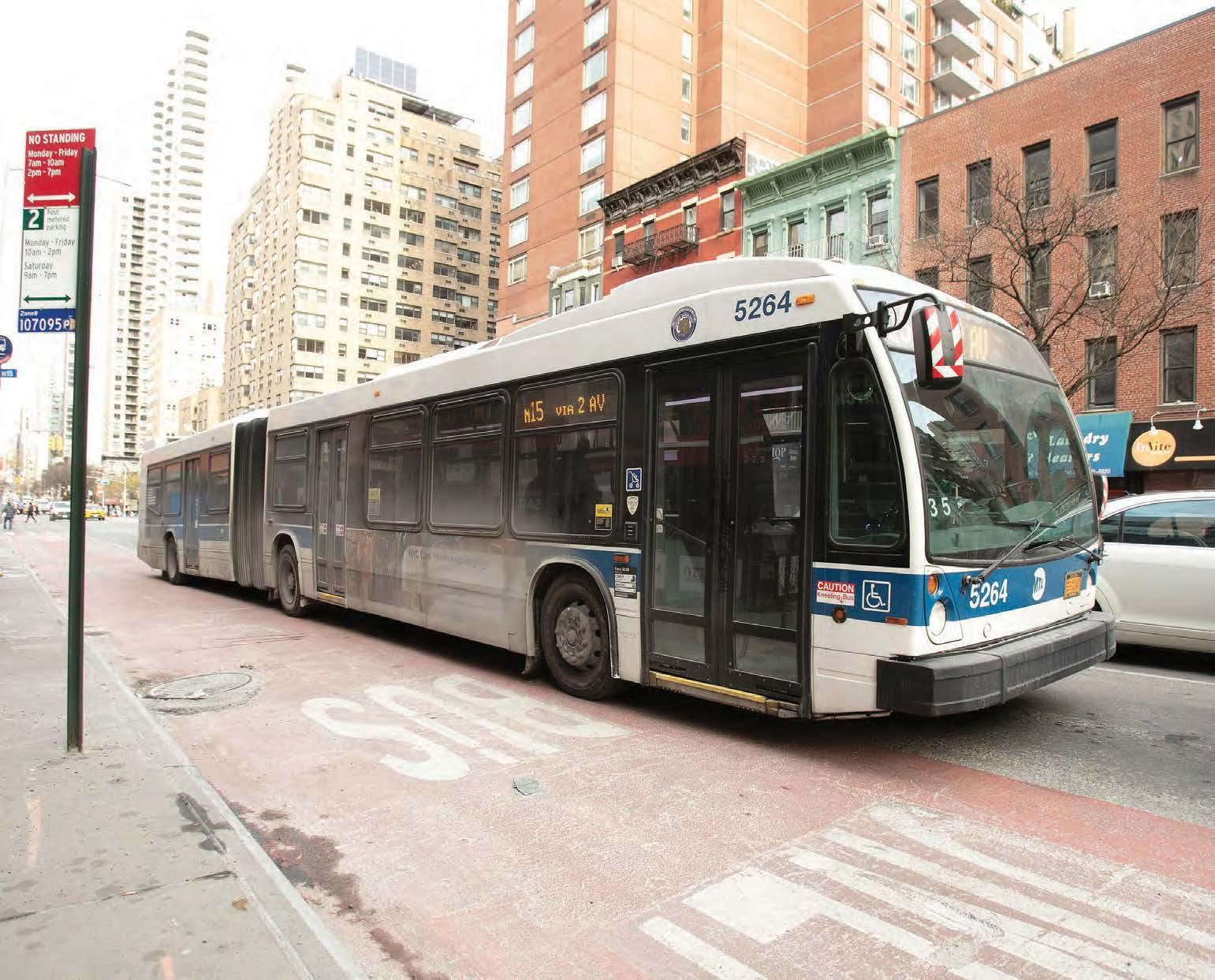
State lawmakers have hit the gas on $12 million in upgrades for express and local routes ahead of the expected June start of congestion pricing.
e state budget passed on April 20 includes $12.3 million for improved bus service across 21 bus routes, including increased peak service on express buses from the boroughs into Manhattan’s core.
However, the new investment falls well short of the $45 million that state Senate Deputy Leader Michael Gianaris and Assembly member Zohran Mamdani, both representing Queens, had pushed for to make bus service more frequent and reliable ahead of congestion pricing. The proposal sought to follow London, Stockholm and Singapore in enhancing mass transit options in anticipation of congestion fees.
At the same time, the Metropolitan Trans-
portation Authority’s experiment with ve, payment-free bus routes in each borough will soon come to an end; the new state budget did not reauthorize the pilot program and rejected an expansion sought by Gianaris and Mamdani.
Last year’s state budget greenlit the pilot at a cost of $15 million for ve bus lines — the M116 in Manhattan, the B60 in Brooklyn, the Q4 in Queens, the Bx18 in the Bronx and the S46/96 in Staten Island — but the e ort failed to gain political traction and was publicly spurned by MTA leadership as not worth the investment.
pushed to expand the program from the initial ve to 15 routes with another $45 million in funding. But MTA chair and chief executive Janno Lieber has been frank about his skepticism.
“I am concerned that free buses send the wrong message at a moment that we’re trying to push back on fare evasion.”
Janno Lieber, MTA chair and chief executive
Gianaris and Mamdani, who were responsible for the initial fare-free pilot, had
“I am concerned that free buses send the wrong message at a moment that we’re trying to push back on fare evasion,” Lieber told Crain’s Editor-in-Chief Cory Schouten during a Power Breakfast event April 17. e MTA has not yet released data and analysis from the pilot, but Lieber said the results so far suggest that the fare-free trips are “not necessarily bene tting the lowest income folks” and that he would rather “keep pressing forward on targeted a ordability.”
Transit o cials expect to wind down the fare-free pilot in late summer, ahead of the new school year, the MTA told Crain’s
Other cities’ efforts
Other U.S. cities have tried their hand at fare-free buses with positive results on sped-up travel times. In 2022, Boston made three of its bus routes free — an expansion from an initial pilot program — and Kansas City converted its entire mass transit system to payment free in 2020.
“I’m saddened we were not able to extend or expand the successful fare-free bus pilot,” Mamdani said in a statement, adding that funds to expand the pilot “could be found in the couch cushions of NY’s budget.” “ is was a crucial, universal program that put money back into the pockets of working-class New Yorkers, giving them economic relief and peace of mind.”
The corridor has been losing its mom-and-pop businesses for decades, as tea shops, music venues, budget hotels, movie theaters and banks have departed
The news this month that the former home of Papaya King, a tiny takeout joint on East 86th Street and a mainstay of the shopping strip since the Great Depression, will meet a wrecking ball to make way for housing came as a shock to some observers: How could a longtime business loved as much for its cheap hot dogs as for its quirky neon signs vanish just like that?
But in a way, it shouldn’t have been surprising at all. With tick-tock-like steadiness, East 86th has been losing its mom-and-pop businesses for decades, as tea shops, music venues, budget hotels, movie theaters, pet stores and banks, several of which once catered to the area’s longtime German population, have said auf wiedersehen
In the end, a single-story structure with ample unused air rights serving mango drinks seems to have barely stood a chance in a “highest and best use” analysis, the often ruthless calculation deployed by real estate players to wring the most value out of even specks of land.
It’s clear that the owner of the site, whose address is 171 E. 86th St., has greater aspirations for the low-slung building, which also once included an eyewear store and children’s clothing shop. at owner, developer ZD Jasper Realty, a Long Island-based rm increasingly active across the city, has proposed a 17-story condo with 25 units.
Some recent residential trends involving new homes rather than resales may have inspired its plans.
While activity has been mostly at— 193 new condos sold in Manhattan during the rst quarter of this year versus 201 during the rst quarter of 2023, according to data from Douglas Elliman—prices of those units were relatively strong. e median sale price for new developments was $2.1 million this winter versus $1.6 million the previous year, a hefty 31% gain.
Conversely, any investor looking at similar gures for the retail sector might conclude that storefronts aren’t what they used to be.
In the rst quarter of this year, asking rents for retail berths in Manhattan averaged $255 per square foot on nearby ird Avenue (the closest major retail thoroughfare), according to data from CBRE. is represented an increase from the rst quarter of 2023 but only by about 3%.
e pandemic doesn’t seem to have helped Papaya King’s case. In 2020, its landlord Imperial Sterling dragged the no-frills frankfurter stand to court over alleged non-payment of rent, a case that appeared to be ongoing in 2021, when Imperial Sterling sold No. 171 to residential builder Extell Development Co. for $21 million. Although Extell took steps to raze the site, the developer eventually changed its mind, choosing to unload the corner property at a pro t to ZD Jasper instead.
The challenges that come with mistiming the market seem evident at this site, which is home to an 18-story, 61-unit cond-op originally called the Hayworth. Its original developers, Ceruzzi Properties and Kuafu Properties, assembled the corner site for $119 million in 2014 but didn’t kick off sales until the tower was complete in 2019. By that time, the robust condo market of the mid-2010s had begun to peter out. Company founder Louis Ceruzzi also died in 2017. And then of course came Covid, which in early 2020 ground virtually all projects to a halt. When the team defaulted on its construction loan, lender Children’s Investment Fund, the U.K. hedge fund, moved to foreclose on the project. But developers were simultaneously shopping around the Hayworth, and the team of Zeckendorf Development and the Stahl Organization wound up taking the site, which sits on land leased from the Goldman family, for about $232 million in 2022, records show. Now known just by its address, No. 1289 had by late April sold and closed 34 of its 61 apartments, or about 60%, according to a Crain’s analysis of public records. A 1,700-square-foot two-bedroom unit with two-and-a-half baths was asking $4 million as of April. The white-walled high-rise replaced a retail site whose tenants in recent years have included Petco, Verizon and New York Sports Club. A Dr. Stroer’s School of Languages occupied the site in the early 20th century, vintage photos show.
124 E. 86TH
Developers may be shying away from large new multifamily projects, but East 86th has some notable exceptions. Rybak Development, a Coney Island-based rm that has been particularly active in the Covid era, grabbed this narrow mid-block site in 2020 for $26 million, and after tacking on some air rights from No. 128 in a $3.6 million deal, is putting up a 20-story, 28-unit condo called Arloparc. Amenities include a gym, a music room and a roof deck with a replace. Sales at the limestone condo, which began in spring 2023, are expected to take in about $139 million, according to its offering plan. A spokesman for the project declined to say how many contracts have been signed at the condo, which is to begin closings this summer. A two-bedroom on April 22 was asking $2.7 million, according to StreetEasy. The Beaux-Arts-style bank that once stood on the site contained a branch of the Corn Exchange, a once-ubiquitous retail bank founded in 1853 that Chemical Bank absorbed in the 1950s. Chase Bank later acquired Chemical, and JPMorgan Chase & Co. sold the site to Rybak. Debt for the condo project has come from Valley National Bank, which has so far provided $35 million in nancing, according to the city register. Most of Rybak’s portfolio is concentrated in Brooklyn, but the rm does seem bullish on Manhattan’s East Side. In 2022, Rybak completed Manor 82, a 7-story, 22-unit condo at 333 E. 82nd St.; it also led permits in the late fall for a 23-unit offering at 656 Lexington Ave., a single-story retail building at East 55th Street.


A union hall for musicians, many of them German, occupied this spot until the mid-1960s, when the Ornstein family developed a 9-story of ce building on this lot.“Musical Mutual Protective Union” remains inscribed on the back wall facing East 85th Street, but “Yorkville Medical Arts” is the name of the site today. A theater has been tucked inside the walls since 1904, according to the Cinema Treasures website, though its appearance has changed greatly over the years thanks to much slicing and dicing by its owners. A single-screen offering with 700 seats that showed German language lms in the mid-20th century morphed into a 2-screen version by the 1980s and then a 4-screen cinema in the 1990s before going dark in 2019, though its marquee survives. Its owner appears to be the Perlbinder family, a four-generation real estate clan, according to the city register. Joseph Perlbinder built housing in Brooklyn in the early 1900s, while son Julius later developed Manhattan apartment complexes such as 35 E. 35th St. in Murray Hill. Julius’s son Barton, who goes by Mark, meanwhile, completed the condo Morgan Court at 211 Madison Ave. in the 1980s.
171 E. 86TH ST.
The small retail building at this site, which for decades housed a Papaya King stand—its 1930s-era opening seemed to mark the rst time the classic New York combo of hot dogs and sweet drinks were offered—was gobbled up by luxury builder Extell Development Co. before being of oaded to developer ZD Jasper Realty last year. The company, whose chief is Tom Wu, led plans in April for a 17-story, 25-unit condo project. Papaya King was on the outs with its landlord at the site after allegedly missing more than $120,000 in rent payments during the pandemic. After closing in 2022, the stand tried to make a go of it across the street in a former sports store at 1535 Third Ave., but it never really got off the ground. ZD Jasper, meanwhile, has two projects afoot near Hudson Yards, a 52-unit development at 439 W. 36th St., and a 174-unit, two-towered version at 501 and 489 Ninth Ave. In April, the rm also picked up a sizable Long Island City development site for $47 million.
225 E. 86TH ST.
The street’s shift from retail to residential really began generations ago. Originally home to a German beer hall on a strip teeming with nightlife, this site housed a trendy live music space called Barney Google’s by the late 1960s. Behind a facade lined with candy-colored signs were performances by acts like Tina Turner. Movie director Woody Allen, known for playing the clarinet in regular gigs with jazz bands at the nearby Café Carlyle, apparently launched his local live music career in 1970 with Wednesday night shows at the address. A few years later Barney Google’s became a disco where women were allowed in free before 10 p.m., according to an ad. Real estate interests came knocking by the early 1980s, when developer Joseph Neumann attempted a condo conversion of the mixed-use site, though Neumann did not complete his effort for unknown reasons. A subsequent developer, Roberto Spinelli, tried to pick up the pieces, but he died in 1986, apparently also coming up short. (Spinelli’s partner, the late architect Rafael Vinoly, was executor of Spinelli’s estate.) The rm APM Group nally brought the project across the nish line in the late 1980s, completing a 60unit project that raked in $18 million, according to its offering plan.
310 E. 86TH ST.
Like many stretches of the street, the southern side of this block for years included row houses with faded grandeur. A previous retail tenant in one of them, at No. 310, was a holdover from Yorkville’s German heyday, M. Rohrs’ House of Fine Teas and Coffees. Founded in 1896 and located at different addresses around the Upper East Side in the years since, the narrow 1,800-square-foot berth at No. 310 sold 90 types of its namesake beverages as well as German beers. But M. Rohrs reportedly had a hard time keeping customers as the Q line extension project in the late 2000s turned Second Avenue into a clamorous construction zone, and the store closed in 2011. A Petland Discount followed. In 2019, developer Izaki Group Investments razed No. 310 and four buildings around it, a span from No. 306 to No. 314, to make way for the Harper, a 20-story, 62-unit condo project named for the author Harper Lee, who lived on nearby East 82nd Street. A decades-old Israeli rm whose U.S. division is headed by Eldad Blaustein, Izaki is offering two- to four-bedroom units.
Some nonpro t groups may also view this block as underbuilt, like at this site, a ve-story prewar structure that for decades contained a single-room occupancy property known as the York Hotel. In 1994, Postgraduate Center for Mental Health, a nonpro t formed in 1945 to help returning World War II veterans, purchased the York and converted it into a 35-unit affordable housing site. But two years ago, the center led plans to demolish the gabled building. At the same time, the group, whose CEO is Jacob Barak, has taken steps to increase the size of what might come next. In January Barak purchased air rights from two nearby buildings, Nos. 222 and 230, for $7.5 million, records show, which could allow for a tower at No. 222 with up to 55 units, according to zoning documents. Barak has come under criticism in recent years for allowing poor conditions at some Postgraduate sites, though they appear to be ones operated rather than owned by his nonpro t, and he has blamed a lack of public funding for their challenges. Postgraduate Center reportedly has $130 million in reserves that can be tapped for its real estate. A phone message left for Barak was not returned.

Les Hiscoe is CEO of Shawmut Design and Construction, a $1.6 billion national construction management rm that’s built New York’s iconic spaces for more than 30 years.
The world has changed. Industries are increasingly competitive and demand more service, value, and transparency than ever before. To meet these demands, leaders need a fresh skillset. Empathy, open-mindedness, and a willingness to embrace innovation are crucial in shaping the trajectory of an e ective leader and successful business. Maintaining mental health as a cornerstone of workplace culture, understanding the implications of AI, and supporting diversity and inclusion have to be faced head-on, with a clear commitment to values and a people- rst culture.
Mental health
Mental health considerations have become an expectation in company culture. In construction speci cally, the industry’s high suicide rate and opioid crisis demand an accelerated commitment. To e ect meaningful change, leaders need to address stigmas and lead by example, modeling their own self-care. Shawmut’s leaders have undergone training on how to avoid or manage burnout—both for themselves and their teams—including being
cognizant of energy drains. Shawmut’s culture of care starts with empathetic leadership, informing all our decisions and guiding our mental health work, which we extend to all our projects. rough our Culture of Care Toolbox Talks—monthly jobsite discussions with trade partners dedicated to psychological safety and mental health—we raise awareness around topics including empathy, substance use disorder, fatigue and suicide awareness. Last year, we launched our Mental Health & Wellness Leadership Group with over 50 members accelerating our work, with a dedicated work ow speci c to jobsites and trade partners.
Arti cial intelligence
AI and its implications for the future of work are changing by the day. With its enormous potential comes signi cant unknowns, including employee anxiety around being outpaced or outsourced and unease among clients who may not trust or understand the technology. But with construction productivity showing no improvement since 1970, the industry has a lot to gain with clear-headed leadership and thoughtful integration
of AI. Innovating operational processes is essential with rising costs and a continued shortage of materials and skilled workers. At Shawmut, we invested in AI for safety to drive us closer to prediction and zero incidents. We created a custom dashboard that aggregates data for AI to analyze and identify risk areas. AI makes our jobsites safer and frees up time for our people to focus deeply and think creatively. As we consider more opportunities to implement AI, we see it as an enhancement—not a replacement—of our people and their knowledge.
Diversity, equity and inclusion
A sustained commitment to DEI must be a business imperative. Recently, DEI e orts have come under scrutiny for lack of commitment and investment. To be e ective, DEI work cannot be lip service, a box-checking exercise or an HR initiative—it needs to be owned by everyone. Creating a workplace of belonging where everyone feels safe and heard means integrating DEI into a company’s fabric. To hold us accountable for driving our peoplerst strategies to create an equitable,
highly energized workplace, Shawmut has 50 leaders across its Diversity Leadership Council and supporting regional councils; our leadership has DEI e orts as established goals and KPIs; and our executive team shares progress with our board of directors for objective measurement. Creating an inclusive workplace and industry is imperative to construction’s future— when people feel respected and included, they deliver their best. is translates to business health, which helps attract top talent to an industry that desperately needs it.
Industry expertise is still required, but it’s no longer an option for leaders to shy away from mental health, AI and DEI. ose who embrace these challenges with foresight and a people- rst approach will position their organizations for sustainable, scalable success and create engaging, rewarding workplaces.

“Today’s complex challenges require leaders to have new skills. Empathy, open-mindedness, and a nimble approach to innovation will drive sustainable, rewarding business growth.”
– Les Hiscoe CEO of Shawmut Design and Construction
Manhattan District Attorney Alvin Bragg will have to prove a novel legal theory in order to win
Alvin Bragg has a very good chance of winning his case against Donald Trump, which began opening arguments on April 22.
e Manhattan residents on the jury hail from one of the most anti-Trump counties in America. Democrats vastly outnumber Republicans here, and Trump, who lies repeatedly and has already been indicted in three di erent federal cases unrelated to Bragg’s prosecution, makes for one of the least sympathetic defendants imaginable.
While one of the federal cases against Trump — allegedly obstructing the federal government in an investigation of his mishandling of classi ed documents — is much more straightforward, Bragg is attempting to convict the incendiary ex-president on the grounds of allegedly paying hush money to a mistress and mucking up the 2016 election.
bursements to his former lawyer and xer, Michael Cohen. Cohen, a key witness against Trump in the case, allegedly paid $130,000 to adult lm star Stephanie Clifford, known as Stormy Daniels, days before the 2016 election, in exchange for her silence about an alleged a air with Trump. Trump denies the allegations and the a air.

ere’s little reason to believe Trump, a serial adulterer who has spent his career partnering with various xers and sympathetic outlets, like the National Enquirer, to pay o anyone who might spread un attering truths about his conduct. As a politician and businessman, Trump is shameless and devoid of scruples.
nary legal expenses paid to Cohen. e trouble for Bragg could be the legal theory underpinning the case. Mark Pomerantz, a former prosecutor in the Manhattan DA’s o ce who was involved in the Trump investigation prior to his resignation in 2022, believed a key legal question was whether Trump could be charged under the felony version of New York’s false records law. e felony statute requires Bragg to prove that Trump falsied records to cover up a crime.
It’s not impossible that the Supreme Court of the United States, with its conservative majority, could decide that it needs to weigh in on whether Trump should be shielded from this particular prosecution.

Donald Trump, who lies repeatedly and has been indicted in three other cases, makes for one of the least sympathetic defendants imaginable, writes columnist Ross
To win, Bragg will have to prove a novel legal theory. In a Manhattan courtroom, he can — but that doesn’t mean the Democrats who revile Trump shouldn’t be at least a little skeptical of his case.
e Manhattan DA’s o ce has accused Trump of violating New York State law by allegedly agreeing to obscure a series of reim-
e question, though, is why it might be a crime that Trump tried to pay o an adult lm star to protect his own political fortunes. Wealthy men have long tried to throw their money at problems to make them go away. What about “hush money” is criminal?
Bragg charged Trump with falsifying business records in the rst degree, a felony. e felony counts arise out of allegedly false entries that Trump made in various business records in order to make the payment to Daniels seem like ordi-
Trump, ultimately, is not being charged with a campaign nance violation or making the payments to Daniels herself. e case rests on violating a law that makes it a crime to falsify business records with the intent to defraud, specically to conceal another crime — the federal legal violations at the heart of Cohen’s conviction.
Normally, falsifying business records in this manner is only a misdemeanor under state law. But someone accused of falsifying business records may be charged with a felony if their “intent to de-
fraud includes an intent to commit another crime or to aid or conceal the commission thereof.”
Bragg has said the Trump Organization records were falsi ed to conceal or aid criminal activity but has not speci ed the exact crime allegedly hidden. is will probably come into view once the trial commences.
e risk for Bragg, ultimately, is quite high. If he loses at trial, Trump scores an immense political victory. His argument that he was the victim of a politicized
prosecution will have much more validity to the average voter in an election year.
If Bragg wins — still more likely with a Manhattan jury — he could have his conviction overturned if Trump appeals to the Supreme Court. at would be, for him, a disastrous setback. But maybe he wins and the case never gets that far — or the Supreme Court sides with Bragg over Trump. We’ll know soon enough.
Ross Barkan is a journalist and author in New York City.
Mayor Eric Adams’ administration wants to place electric-vehicle charging ports meant for buses and trucks at ve locations around the city, part of an e ort to reduce carbon emissions in the city’s freight and transportation industries.
A request for proposals released on April 22 and shared exclusively with Crain’s names ve city-
estate developers, community groups or others — to submit bids to build charging ports that could be used by passenger vehicles, eet trucks or for-hire cars.
e sites include a lot next to the FDR Drive near Stuyvesant Town in Manhattan; another in College Point, Queens; a lot on Staten Island’s North Shore; and two more sites near Arthur Kill on the island’s South Shore. e locations were chosen because they are close to industrial areas and have access to truck routes, said EDC spokeswoman Chelsea Sudaley.
The RFP is among the rst concrete steps being taken as part of the “green economy action plan” which called for investments in low-carbon transportation.
owned parking lots in Manhattan, Queens and Staten Island where the city’s Economic Development Corp. hopes to place charging hubs for medium- and heavy-duty electric vehicles. EDC is asking companies — whether they be electric-vehicle operators, real
e RFP is among the rst concrete steps being taken as part of the “green economy action plan” released by the Adams administration in February, which called for investments in low-carbon transportation. Although EV adoption has steadily grown in the city in recent years, that transition has higher barriers to entry for medium- and heavy-duty vehicles compared to smaller cars, EDC said.
A form meant to encourage partnerships between interested
vendors is due by May 22, with the full RFP due in September. Sudaley, of EDC, said the market for heavy-duty EV chargers is “just emerging” in the city, with these ports intended to meet the industry’s expected growth in the next ve years. e city will leave it up to vendors to decide how many charging ports they would build at each site.
Convert waterfront sites
e RFP, although limited in scale, is one of several e orts the Adams administration has taken to cut climate emissions in the pollution-heavy shipping sector. In February, the city announced plans to convert six waterfront sites to maritime freight hubs in an e ort to increase the use of boats, rather than trucks, for transporting local goods.
e initiatives would contribute to the city’s goal of reducing its carbon emissions 80% by 2050.
Also on April 22, the administration announced the next three companies that will be invited to pilot new climate-friendly technologies at the Brooklyn Army

Terminal as part of a program launched last year. e selected startups are Benchmark Labs, which plans to construct sensors providing AI-based weather forecasts at the terminal; ReVert Technologies, which builds power adapters that use AI to reduce the amount of energy used by pluggedin electronics; and Matcha, an electric-vehicle charging compa-
ny. ( ree initial companies were announced in September.)
“ ese groundbreaking initiatives … will accelerate low-carbon alternatives in the transportation sector, spark cutting-edge innovation that will unlock solutions for the global climate crisis and create new economic opportunity for the city,” EDC president and CEO Andrew Kimball said in a statement.







In neighborhoods across the city, retail closures are often a cause for mourning. But a wave of shutdowns expected in the coming months instead merits a round of applause.
At long last, state policymakers are moving decisively to facilitate the shutdown of thousands of illegal cannabis shops that have spread across New York City, undercutting the state’s legal weed market and contributing to an air of lawlessness.
e state’s new $237 billion budget allows municipalities to seek emergency court orders to shutter the shops and — critically — empowers state and local authorities to seize cannabis and padlock businesses immediately after an inspection if they are found to be selling illicit products or serving minors. e state also plans to go after suppliers who are stocking the illegal shops. And landlords in the city that fail to start eviction proceedings against an illicit shop within ve days of being noti ed could be ned $50,000.
Meantime, conscientious landlords have a new tool to evict tenants in violation of the law: ey will now only have to prove that a business is “customarily or
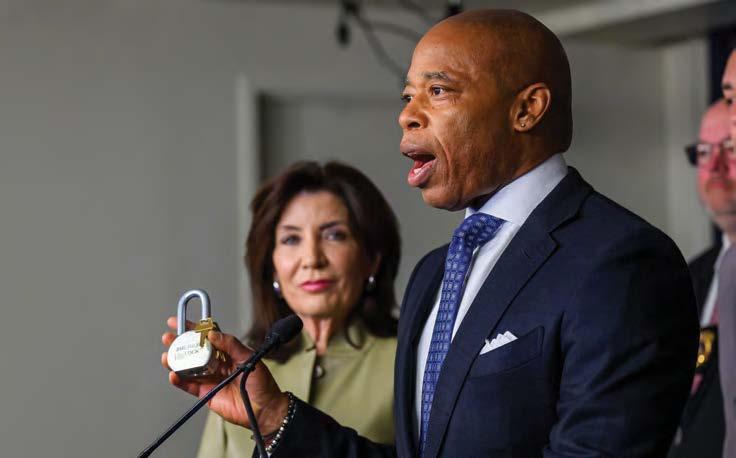

habitually” engaged in selling cannabis without a license, rather than “solely or primarily” doing so.
e policy changes give regulatory and

enforcement agencies all the tools they’ve been asking for, so there should be no more excuses. If the state’s O ce of Cannabis Management and local authorities
including the NYPD follow through, the illicit shops should begin to fall like dominoes. ere’s plenty of work to do: While there are about 100 legal cannabis shops open for business across the state, an estimated 2,000 illegal shops have been operating with impunity in New York City alone.
Change will take time
“ e illegal shops will not disappear overnight,” Gov. Kathy Hochul cautioned at a press conference with Mayor Eric Adams, who had pushed for the crackdown alongside his Albany ally, Assemblywoman Jenifer Rajkumar. “But New Yorkers eventually will see a change in their communities.”
e communities have been waiting long enough; it’s not a big ask to expect government agencies to have planned ahead and put in place common-sense regulation and enforcement mechanisms in advance of legalizing recreational marijuana.
e best time to have shut down the illegal shops was the moment they started popping up. e second best time is now.
Community boards must be open to change and collaboration in order to truly serve their purpose
THE CITY’S COMMUNITY BOARDS are the most basic form of democracy that we can all experience up close. Made up of volunteers, primarily advisory, they still play a key role in relaying neighborhood opinions and emotions to our elected o cials. is is especially true about land-use issues, which are as crucial as they’ve ever been in New York City. I should know: I spent roughly 30 years as a member of Community Board 5 in Manhattan, several of them as chair. And so I’ve watched with a keen eye the recent upheaval occurring there.
To make a long story short, a group of folks frustrated by the slow pace of developing housing in CB5 — which includes most of the Midtown business and Flatiron districts — staged what is essentially a coup d’etat, replacing many long-term board members in leadership positions, many of whom I worked with back in my day. ese are hard-working, dedicated folks, and when they resisted plans for new housing — and shared their concerns with our government — they did so out of genuinely held beliefs that it was the right thing to do, and that it was what their neighbors wanted. Sorry, but democracy is messy. Sometimes new blood, new ideas and
new viewpoints are needed. So while I’m sorry for my former colleagues, I want to remind everyone that this is what government is all about. Or least, what it’s supposed to be about — the House of Representatives in Washington these days is a bad example of how di erent sides are supposed to compromise to nd solutions. ey seem incapable of even talking to each other.
But let’s not use that dysfunctional body as an example, because by any standard it’s a bad example. Let’s remember that there are two or more, sometimes many more, sides to each issue, and sometimes we need to bend to get things done.
I wish the new leaders of CB5 all the luck in the world, although their ascent might have been heavy-handed. And I counsel those who disagree with them or are angry about how they came to power, to put aside those feelings. Work with them. Find solutions. Washington might be a mess, but CB5 doesn’t have to be.
Michael Presser is a former chairman of Community Board 5 and is the current executive director of Inside Broadway, a nonpro t that exposes public school students to the world of New York theater.

As a social justice advocate deeply invested in the well-being of my broader community, I nd myself increasingly troubled by the pervasive impact of a deceptive hospital billing practice called “dishonest billing.” Dishonest billing is when a hospital secretly reclassies a doctor’s o ce they own as a hospital setting in order to get more money. e disturbing trend of hospital conglomerates acquiring independent physician practices and subsequently hiking prices for routine doctor services is not merely an issue con ned to the healthcare sector; it poses a direct threat to the health and wellbeing of individuals and small businesses, and the impact is exacerbated in vulnerable, underserved communities.
nesses, limiting their ability to provide employees with the bene ts they need.
As hospital conglomerates ex their acquisition muscles, the prices for routine doctor services skyrocket, leaving small business owners grappling with the dicult decision of balancing employee health coverage and the growth of their enterprises. is dilemma is exacerbated by the fact that these exorbitant costs often force small businesses to choose between providing adequate healthcare bene ts and investing in expansion, hiring, and innovation.

Dorian Bess is the program development and engagement o cer with the Social Justice Network.
As a justice-impacted citizen myself, I know how critical stable employment is to successful reentry e orts. Small businesses are the backbone of our great city and state – according to 2023 data from the U.S. Small Business Administration, New York’s 2.2 million small businesses make up 99.8 percent of all businesses in the state. Given this, one of the most immediate challenges dishonest billing poses is the nancial strain it places on small busi-
Justice-impacted individuals cannot succeed without employment that provides quality, a ordable healthcare. However, the surge in health care costs resulting from deceptive billing practices, like dishonest billing, puts small business employers in an untenable position. An annual survey by the Business Group on Health found that the average cost of health care per worker increased from $15,862 in 2022 to $17,200 in 2023. e reality of soaring medical expenses leaves small business owners with fewer resources to allocate towards essential business initiatives that directly impact individuals and families in the communities I serve.
e consequence of these decisions re-
verberates beyond the con nes of our business walls and extends into the wider community. Small businesses are the backbone of local economies, and when their growth is stunted, so too is the economic vitality of the communities they serve. Reduced expansion and hiring opportunities limit the potential for increased employment and economic prosperity, which, in turn, a ects the overall quality of life for community members.
Furthermore, dishonest billing contributes to a growing sense of disillusionment among Americans who feel caught in a relentless cycle of nancial strain. For small business owners, this strain not only impedes their ability to provide competitive wages and bene ts but also hinders their capacity to contribute to community development initiatives and support local charities or events. For individuals, this strain discourages people from seeking proactive medical care for routine services as well as mental health services.
Policymakers must prioritize the creation of an environment that encourages competition and innovation, allowing smaller health care providers to operate independently and small businesses to offer a ordable services to their employees.
e New York State Assembly should enact legislation to ban dishonest billing and curb the unchecked power of hospital conglomerates, forcing them to justify and

communicate any price increases for routine doctor services. Additionally, New Yorks’ federal representatives should support the Site-based Invoicing and Transparency Enhancement (SITE) Act, sponsored by Sen. Braun (R-IN) and Sen. Hassan (D-NH) which would provide hospital billing transparency for Medicare recipients.
As a community, we must unite to demand change and challenge a health care system that places pro t over people. By advocating for fair and transparent hospital billing practices, we can work towards a future where small businesses can grow, individuals are given a second chance to access employment with quality health care coverage, and communities can ourish.
It’s anticipated that as arti cial intelligence technologies mature, they will unlock over $17.7 trillion in economic value each year by boosting performance and productivity across the global workforce. With 40,000 AI professionals in our workforce—second only to Silicon Valley— New York is positioned to capture an outsized share of those gains.
But there’s a catch: while New York is ahead of the curve when it comes to regulating AI, we still aren’t doing enough to make sure that the bene ts of AI tools and technologies are felt by everyone in the workforce.
e problem is that AI is often seen chie y as a way of augmenting the performance of ofce-bound knowledge workers — not of supporting the 80% of employees who don’t do their jobs sitting at a desk. Take Walmart, for instance: despite the company having provided 740,000 smartphones to associates in a bid to digitize in-store operations, the company’s recently unveiled generative AI toolkit was designed speci cally to help non-store employees.
on some of the most compelling potential productivity and performance gains these technologies are capable of delivering.

Fabrice Haiat is co-founder and CEO of Midtown-based startup YOOBIC.
Now, there’s nothing wrong with using AI to support o ce workers. It’s been shown that generative AI tools, for instance, can improve the performance of such workers by as much as 40%. But we shouldn’t only be using AI tools to support desk-based employees — because if we do, we’ll miss out
e lack of attention to the front-line applications of AI shouldn’t come as a surprise: the world’s deskless workers — all 2.7 billion of them — have long been neglected by tech innovators. e vast majority of tech venture funding goes to companies that support white-collar workers. Meanwhile, just 10% of deskless workers believe they have access to the tools and technologies they need to do their jobs e ectively, and less than half say they’re given meaningful opportunities to learn new skills at work.
Our tendency to treat deskless employees as second-class citizens is anchored in an outdated view of front-line teams as focused on transactional tasks and manual labor, rather than real knowledge work. e reality, though, is that in today’s connected workplace, front-line teams drive incredible value for their organizations by serving as expert sources of market intelligence, custodians of brand identity and customer relationships, and powerful drivers of business process innovation.
Given this, smart leaders increasingly view their front-line teams not as mere labor, but as mobile knowledge workers. Em-
powering these vital employees — and nding ways to use AI to augment their activities — is a vital step as businesses of all kinds look to beat burnout, boost retention, and empower front-line teams to drive productivity and performance across the value chain, improve the customer experience, and increase revenue.
So what can AI, speci cally, deliver for today’s front-line teams? e answers are as varied as the roles and responsibilities that front-line workers take on. ere’s one key insight to remember, though: while front-line employees are every bit as smart, creative, engaged, and driven as their deskbound counterparts, they’re seldom given the tools and resources to truly unlock their full potential. is isn’t just a question of underfunding or neglect — it’s also because, by their nature, front-line teams work in fast-changing and challenging mobile environments, and lack access to many of the tools used by deskbound knowledge workers. Unlike ofce workers, front-line teams need to be able to access the support and resources they need while on the oor, using whatever devices they have to hand, without disrupting high-stakes work ows. at’s where AI can play an enormously bene cial role. Where an o ce worker can take the time to scroll through a website or click through a PDF to nd the information they need, for instance, a front-line worker could use GenAI — perhaps via a hands-

free voice-operated interface — to rapidly surface the exact information they need in a particular moment.
It’s even possible to use AI to automatically moderate chatrooms and peer-to-peer communications, creating a safer and more inclusive way for front-line teams to stay in touch — or to proactively connect employees with real-time support for HR or work-related issues, as well as the wellness and mental health resources they need based on the speci c stresses and pressures they’re facing.
By customizing, targeting, and streamlining the ow of information to individual teams, and helping to proactively surface emerging and established best practices across the entire workforce, AI tools can drive powerful bene ts for deskless teams — more fully establish front-line employees as engaged, equal, and empowered members of the workforce. In this way, AI can become a workplace equalizer, giving all workers access to a wealth of knowledge, resources, and support they need to thrive.


Omnibuild, the former construction manager for embattled developer HFZ’s XI project, is suing the real estate rm for roughly $350 million in a sweeping lawsuit that claims it was ignored and rebu ed at every turn when it tried to bring up nancial problems at the luxury condo development.
e Manhattan District Attorney’s o ce recently indicted multiple employees at Omnibuild for allegedly being part of a criminal conspiracy orchestrated by former HFZ executive Nir Meir. But the Omnibuild lawsuit claims the company was “wrongfully indicted” in that case and was warning about possible nancial issues at the XI dating back to 2019. e company said it only
“Omnibuild is a victim of HFZ’s criminal theft and the negligence of multiple parties put in place to protect us.”
Josh Vlasto, Omnibuild spokesman
continued working on the project because of assurances from HFZ that ultimately proved to be false.
“As we have said since the |beginning of this investigation, Omnibuild is a victim of HFZ’s criminal theft and the negligence of multiple parties put in place to protect us,” said Omnibuild spokesman Josh Vlasto. “ e contents of this lawsuit prove just that.”
HFZ hired Omnibuild to be the construction manager for the XI, located by the High Line at 76 11th Ave., in 2016 and was falling behind on its payments by spring 2019, according to Omnibuild’s lawsuit, led April 19 in Manhattan state Supreme Court. Omni-
build sent its rst written notice about this to HFZ that May, also noting that the project appeared to be going over budget with no plan to address the shortfall.
Omnibuild did not get a response to this notice or a second one, so the rm sent a third one to HFZ and the lenders that June, the lawsuit says. However, this one also sparked “no meaningful response whatsoever,” according to the suit.
e construction rm sent several more default notices over the ensuing months and were “bafed by the complete lack of response,” the lawsuit says. In April 2020, Omnibuild warned all subcontractors on the project about HFZ’s defaults and recommended they not deal with the developer directly, and in May, an Omnibuild principal demanded Meir stop pressuring their accountant Kevin Stewart to sign documents on Omnibuild’s behalf. (Stewart and Omnibuild coCEO John Mingione were both indicted in the Manhattan District Attorney’s investigation.)
In all, Omnibuild sent 16 notices of default to HFZ and the lenders between May 2019 and June 2020 and warned in its nal one that HFZ could be “subject to criminal sanctions” if they were found to be inappropriately using the funds at issue, according to the lawsuit.
“ is is a serious matter which cannot simply be brushed aside based upon the undocumented and unsubstantiated claims of the owner,” Omnibuild wrote, according to the lawsuit.
Omnibuild sued HFZ for roughly $100 million worth of missing payments soon after its nal default notice.
Julianne Cuba
e Brooklyn Navy Yard Development Corp. is seeking ideas from manufacturers who are focused on climate change or clean energy infrastructure to redevelop a massive, currently vacant building on its sprawling waterfront campus.
e nonpro t corporation that serves as the real estate arm of the approximately 300-acre cityowned industrial property released a Request for Expressions of Interest this month for the development and operation of a 2.75-acre parcel right on the edge of Wallabout Bay.
with the Navy Yard to host live music and other cultural events, such as fashion and art shows, according to Stephanie Báez, a spokesperson for the Navy Yard corporation.
rm would have stopped working on the project almost immediately after these defaults started, allowing it to mitigate its losses and avoid being criminally indicted, if not for repeated false statements about its nances from HFZ and the lenders, according to the lawsuit.
Omnibuild is suing HFZ and the project lenders for fraud, negligence and breach of contract.
Omnibuild’s $100 million claim against HFZ during the summer of 2020 was one of the rst lawsuits to hit the company. An avalanche of additional ones soon followed, and the onceprominent developer is now essentially defunct. Ziel Feldman, who ran the rm along with Meir, has placed the blame for the company’s problems squarely on Meir and is not expected to be charged in the criminal case. He is, however, named as a defendant in the Omnibuild suit.
Feldman and a representative for the Manhattan District Attorney’s O ce declined to comment. A representative for Meir did not respond to a request for comment by press time.
e Manhattan District Attorney’s o ce has accused Meir of orchestrating an $86 million scheme that included using money for the XI for other developments and forging bank statements to make it seem like HFZ had more money than it did. Ocials have accused Omnibuild of taking part by making it seem like they were further along on the XI than they actually were, causing the project’s lender to release more funds.
Dubbed ‘Building 293,’ the existing 104,000-square-foot structure at the intersection of Gee Avenue and Assembly Road, stands just one story tall and boasts 32- to 50-foot-high ceilings. It’s equipped with 10 loading docks and can accommodate up to 50 adjacent parking
But those interested in its longterm use are free to use the building however they like — except as a live concert venue — and as long as its purpose is to facilitate the creation of clean energy infrastructure or help advance the city’s goals of addressing climate change and generating more jobs for the green economy. e eventual awardee can either demolish the whole structure and build an entirely new facility on its footprint or use what’s currently there, according to the document.
Home to over 550 businesses
e Brooklyn Navy Yard — which is currently in the process of building out its master plan, a $2.5 billion roadmap from 2018 that envisions about 5 million square feet of new manufacturing buildings on its campus — is home to more than 550 businesses and 11,000 workers and generates more than $2 billion a year for the city.
The Navy Yard had issued a request for proposal to develop a new industrial and commercial building along Kent Avenue — the rst of three major ground-up projects under the master plan.
spaces, according to the proposal published in the City Record on April 17.
e building was erected in 1970 for the construction of shipping components and is otherwise vacant except for the occasional raves and concerts thrown at the site by entertainment companies Broadwick and TCE. ey operate as part of a joint venture under a short term agreement
Crain’s reported last year that the corporation had similarly issued a request for proposal to develop a new industrial and commercial building along Kent Avenue — the rst of three major ground-up projects under the master plan.
The Navy Yard is currently 91% occupied, according to Báez. And City Comptroller Brad Lander’s most recent audit revealed that as of June 2023, the Brooklyn Navy Yard Development Corp. reported current assets of $50.1 million and noncurrent assets of $1.2 billion consisting of restricted cash, tenants’ security deposits and lease payments.
e construction
e Manhattan District Attorney’s o ce indicted Meir earlier this year over “the precise illegal activity” Omnibuild had reported in its 2019 and 2020 notices, its lawsuit says.
Mingione and Stewart were arraigned and released in the criminal case on Feb. 7, while Meir was arraigned on Feb. 21 and held on $5 million cash bail. ey are next due in court on May 7.

Although civil enforcement against many of the shops selling marijuana without proper licensure has been going on for more than a year, it has not been e ective thus far, Gov. Kathy Hochul said.
“We hit these shops with a fine, hearings, and appeals, they drag on. Guess what? During that process, they stay open and haul in more and more cash, and every -
process plays out, the padlock stays on.”
The padlock approach is the first step in Hochul’s plan. Once authorities verify that any shop is “selling products not tested or labeled in accordance with our laws … the padlock goes on immediately,” Hochul said.
The second step grants municipal and county governments new authority to create their own similar parallel laws to padlock illicit cannabis shops within their own jurisdictions, thereby broadening the enforcement manpower and resources across the state.
“This is not a step backwards. This is a step forwards, to make sure we have legal cannabis shops. Legalization is about following the law, not breaking the law.”
Eric Adams, NYC mayor
body knows it. Right now, these fines are just a small cost of doing business in their minds,” the governor said.
“But you know what’s hard to factor into your business model? Having your front door padlocked for up to a year. You can appeal the fine, you’ll get your due process, but while the due
“Localities were stuck on the sideline in this fight. That ends right now. Now, they have the power to enforce,” Hochul said.
In New York City, Hochul said, the sheriff’s office will be engaged to deputize New York Police Department officers to help in padlocking illegal marijuana shops.
“See what we’re doing here? Bringing a lot of people out to say, ‘the gig is up,’” Hochul said. “It won’t just be the state coming after you.”
A third step, she said, is new power to revoke the liquor, tobacco, and lottery sales licenses of bodegas or other shops that are found to be selling illegal or unlicensed marijuana goods, particularly those smuggled in illegally from out of state.
The fourth step is to go after landlord with even more civil fines of up to $50,000 if they knowingly let shop tenants sell illicit cannabis, Hochul said.
The fifth and last part of the plan is a statewide task force, spearheaded by the state police, to help coordinate enforcement against the illegal market and to go about “busting up the pipeline of illegal cannabis coming in from other states.”
Beyond enforcement
Hochul also said that a “top priority” for her is getting more state marijuana business licenses issued so that the legal market can supplant the illegal one.
Thus far, there are just over 100 legal cannabis shops operational in New York, contrasted with estimates of 2,000 or more illegal shops in New York City alone.
“That is a top priority of mine. We have a lot of catch up to do,” Hochul said of getting more cannabis licenses issued by the

Cannabis Control Board.
e governor further emphasized that the new enforcement push is not — as some activists have feared — a return to the days of marijuana prohibition.
“ ese enforcement measures … go hand in hand with equity,” Hochul argued. She asserted that justiceinvolved cannabis entrepreneurs and legal businesses are the most harmed by the illicit market.
“ ey’re the ones losing money,” she said.
Mayor Eric Adams echoed that sentiment and said the new enforcement push is about supporting businesses that have tried to play by the rules.
“ is is not a step backwards. is is a step forwards, to make sure we have legal cannabis
shops,” Adams said. “Legalization is about following the law, not breaking the law.”
One of the few legal entrepreneurs who’s been able to open thus far — e Cannabis Place Dispensary CEO Osbert Orduña of Queens — said the new plan is “common sense.”
“The unchecked growth of unlicensed cannabis establishments and the unscrupulous landlords who enable them creates significant risk to our public safety, consumer health, and the integrity of the legal cannabis industry,” Orduña said.
Hochul said the new enforcement push is likely to begin as soon as the state budget is finalized by the legislature and then signed into law. is article originally appeared in Green Market Report.
Cuba
We’re not in Nashville anymore. e short-lived Opry City Stage in Times Square is being remade into a four- oor nightclub and restaurant, Crain’s has learned.
Entertainment company HK Hall, which operates a 5,000square-foot venue at 605 W. 48th St. in Hell’s Kitchen, plans to open the new venue in mid-May, according to Paul Brown, one of the partners behind the remodeled space at 1604 Broadway, which will operate as restaurants by day and as a nightclub by night.
A spino of Tennessee’s famous Grand Ole Opry, the Times Square location, between West 48th and West 49th streets, opened to much fanfare in 2017. But the New York country music venue, operated at the time by Ryman Hospitality Properties, apparently just couldn’t make it in the big city, and closed after less than a year, in 2018.
None of the Dolly Parton-esque ephemera in the old haunt remains, according to Brown, who said the new venue is in its last phase of construction and will be a state-ofthe-art facility with two stages.

Brown said he signed a lease for the space with landlord Farmore Realty about a year and a half ago and has since done a “gorgeous renovation.” He declined to say how much he’s paying in rent, but the average cost per square foot
for ground- oor retail in Times Square was $1,267 during the rst quarter of 2024, according to a recent report from JLL.
Brown said he and his business partner—Latin nightclub promoter Pedro Zamora, who appears to
be friendly with Mayor Eric Adams, according to his social media accounts—are just waiting for the certi cate of occupancy from the city before throwing a grandopening party. A 32-foot-high billboard outside the space to pro-
A 32-foot-high billboard outside the space to promote the club’s events, such as re breathers, artists and other performance acts, is nearly ready to go.
mote the club’s events, such as re breathers, artists and other performance acts, is nearly ready to go, he said.
e overall property will not have a name, according to Brown, but the Times Square venue’s rst oor will be home to an eatery Brown is calling Broadway Pizza and Bites; the second and third oors, a Latin restaurant called Circo; and the fourth oor, an American diner called Palma Verde. And when the property is not being turned into a Latin nightclub on Fridays or an EDM show on Saturdays, it will also host private events such as weddings, and bar and bat mitzvahs. Farmore Realty did not respond to a request for comment by press time.
No hitting the brakes here.
Electric automotive company Tesla is opening up its second showroom in Brooklyn and third in the city, amid layo s at the Austin-based enterprise elsewhere across the globe, Crain’s has learned.
e maker of the divisive Cybertruck — which starts at $60,990 and has been beset by accelerator complaints — debuted its New York City dealership in the Meatpacking District at 860 Washington St. in 2009. e second Tesla dealership in the city opened in Red Hook at 160 Van Brunt St. in 2016, and now, a third is planned to open at the Roulston House at 94 Ninth St. — just steps from the fetid Gowanus Canal.
pansion in the borough, according to Joseph Hamway of Industrie Capital Partners, who owns the Ninth Street o ce building at the corner of Second Avenue as part of a 50-50 partnership with Bobby Cayre of Aurora Capital. e Roulston House opened two years ago and is fully operational as a “successful, creative o ce” building, according to Hamway, save for the forthcoming Tesla showroom. Hamway declined to say for how much the Musk-owned company is leasing the space.
Founder and CEO Elon Musk has no apparent plans to back out from his imminent expansion in the borough.
A polarizing gure in the business world, Tesla founder and CEO Elon Musk has no apparent plans to back out from his imminent ex-
Hamway told Crain’s April 18 that Tesla is “about to” open soon, but could not specify exactly when. He declined to comment on the news that Musk, who also runs the private rocket company SpaceX, is laying o 10% of his global workforce, including 285 employees across two di erent Tesla locations in Bu alo, according to a notice from the Department of Labor on April 17 that cited economic reasons. Tesla’s stock took a bit of a nosedive this month after the job cut revelations, falling to its lowest level in almost a year, according to reports.

City records indicate that the electric-vehicle maker most recently renewed its Certi cate of Occupancy with the Department of Buildings last month — a ling that lasts for three months at a time and costs $130. e latest renewal was issued on March 12 and is valid until June 10, according to a spokesperson for the Department of Buildings. Tesla rst obtained the required authorization in 2022 for a motor vehicle showroom, auto dealership, auto repair and accessory storage on the entire ground oor, according to city records.
facade of the 4-story brick building. Just outside is the site where 37-year-old Sarah Schick was killed by a truck while riding a Citi Bike in early 2023. A white ghost bike now stands at that corner to honor her memory.
e company’s iconic red-andwhite logo is now hoisted on the
Tesla did not respond to requests for comment.

ere is a lot of noise surrounding the fate of New York’s tech sector. While venture capital investment remains slow, IPOs are starting to return. On Wall Street, the arti cial-intelligence craze jolted equities to all-time highs, but money managers continue to hedge their bets.
As Crain’s has reported, industry analysts remain bullish on New York. Deals may be down, they say, but the city is over owing with available tech talent. C-suite executives are con dent in their companies’ growth in New York, and more tech rms are choosing to do business here than ever before.
Is that optimism warranted? Just ask the tech workers who are ocking to New York. Roughly 14.3% of all U.S. tech employees who relocated to a new city last year landed in the Big Apple.

at’s according to an analysis from venture capital rm SignalFire, released April 15 and rst reported on by the Wall Street Journal. SignalFire mapped the cities where tech workers are leaving and identi ed the most popular destinations where they are going.
e report found that New York was by far the most popular destination for relocating talent in 2023.
e 14.3% in ux gure was nearly double that of the next most targeted city, which was Austin, Texas.


Roughly 10.7% of New York’s existing tech workforce left the city, SignalFire found, but the strong in ow of workers outpaced the out ow. “NYC is in the midst of a tech talent boom,” the report said.
Other cities that saw year-over-
year increases in tech talent include Los Angeles, Denver, San Diego, Miami, Dallas, Nashville and Tampa.
e largest source for relocating tech talent to New York was San Francisco, with Bay Area trans-



Roughly 14.3% of all U.S. tech employees who relocated to a new city last year landed in the Big Apple.
plants making up roughly 37% of the city’s tech talent intake. New York also attracted talent from Seattle and Boston.
San Francisco continued to attract new talent, the report said, but employees left at a faster rate. For every tech worker who moved from New York to San Francisco, 1.4 workers made the opposite move, according to SignalFire.
SignalFire noted that “overall population trends in the postpandemic period were largely driven by people entering and leaving the tech workforce as the 2021 boom was followed by years of layo s.” eir analysis looked speci cally at existing tech workers who relocated in 2023. e sample size, according to WSJ, was roughly 57,000 tech employees on the move.


e Eretz Group is in danger of losing another Manhattan building to foreclosure.
And in a presumably awkward scenario, the group that aims to seize and sell 224 W. 57th St. is essentially the building’s main tenant.
Soros Fund Management, the asset manager for investor George Soros, has led a foreclosure lawsuit against Eretz for defaulting on a $145 million mortgage for the Midtown property, which is home to Soros’ grant-making group, Open Society Foundations.
e suit, led in Manhattan’s Supreme Court on April 19, accuses Eretz of failing to pay o the loan’s principal by its maturity date of June 2023 and two subsequent deadline extensions.
Soros Fund seeks to take title to the building, a prewar landmark at Broadway, and unload it to pay o Eretz’s debt plus interest and fees, according to the ling.
And the legal action comes just a few weeks after a lender moved to foreclose on a di erent Eretzowned site, an 18-story o ce building at 252 W. 37th St. in the Garment District.
Reached by phone on April 19 at Eretz’s Madison Avenue o ce, rm executive Nick Mok had no comment on the case, which speci cally names rm founder Abraham Talassazan as a defendant. Talassazan signed the original loan documents, records show.
In addition emails sent to Open Society Foundations and Soros
Fund Management were not returned by press time. And a phone message left for a Soros attorney in the case, Jack Doherty, was also not returned.
While persistently high vacancy rates have doomed some landlords, 224 W. 57th St. would seem relatively well o .
Indeed, the entirety of the o ce portion of the 10-story, 170,000-squarefoot mixed-use building is occupied by Open Society, whose lease runs until 2042, according to the data rm CoStar. Open Society, which invests in pro-democracy and public-health initiatives in 120 countries, has an endowment of about $6 billion, according to its website.

Even the retail spaces at the No. 244, which was the media giant Hearst’s headquarters for decades, are completely lled with tenants, including a branch of TD Bank. And a large Nordstom department store is across the street from the renovated address, which is near Columbus Circle.
But full oors might not be enough to o set the other issue dogging the commercial real estate market these days: historically high interest rates, which has sent the costs of loans soaring.
In the past, commercial landlords have taken on massive

amounts of debt with the assumption that they would essentially kick the can down the road when it came to repaying the money by coming up with a new loan package on more favorable terms, a strategy that seems to be back ring now.
According to the city register, Eretz in 2015 paid $213.8 million for 224 W. 57th St., a terracottalined 1910 edi ce that was once known as the Argonaut Building and that served as an early General Motors showroom back when this part of Midtown was nicknamed Automobile Row.
In 2018, Eretz borrowed $145 million to re nance the property from the lender Aareal Capital Corp., which after it could not collect the money it was owed then sold the outstanding debt to Soros Fund Management in the fall, the lawsuit says.
A Bronx-based social services nonprofit plans to open a $12 million housing development in Morrisania for older adults leaving the prison system.
The Osborne Association is scheduled to open the Fulton Community Reentry Center, a 140-bed temporary residence designed to help older adult men leaving the prison system get stable housing after release.
In addition to housing, the center will offer employment assistance, case management and substance use counseling and a community for formerly incarcerated men over 50. The shelter plans to serve older individuals coming out of long periods of incarceration — a population that may face struggles getting a job or reintegrating into their community after release, said Jon Monsalve, interim president and CEO of the Osborne
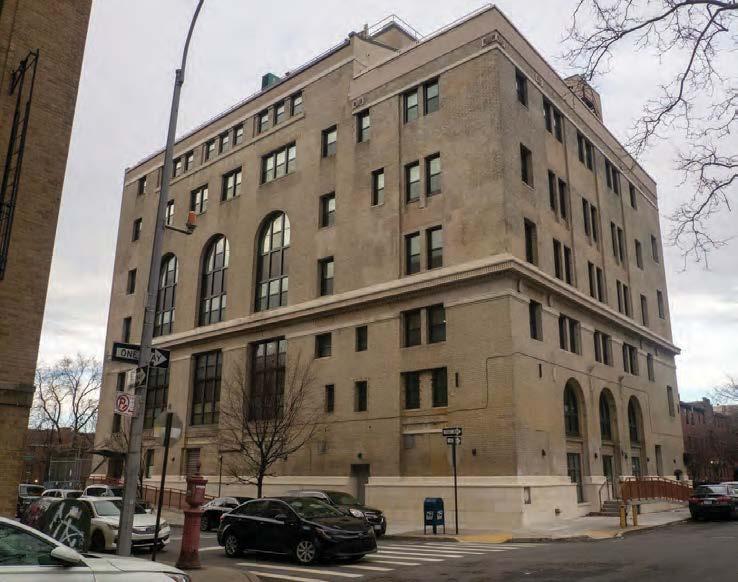
to nd permanent residences for people living there. But Monsalve said that
immediate housing is critical for community reintegration for formerly incarcerated people, as it o ers a path to nding employment and preserving health and well-being.
“ is is the thing that folks worry about the most — where they are going to put their head at night,” Monsalve said.
e Economic Development Corporation provided $6 million to build the Fulton Center, with additional capital funds owing from the City Council and the Dormitory Authority of the State of New York. Osborne received a $138 million
contract from the city’s Department of Social Services to operate the Fulton Center through 2040. e contract will provide roughly $6.8 million in city funds each year.
While DSS provides operating funding for the facility, the Osborne Association owns it, said DSS Commissioner Molly Park. She said the new center represents a “three-way win:” it offers a high-quality residence for the community, it allows the nonpro t to operate and own the building and it provides the city with a new shelter at a xed rent cost.
Park added that Fulton will offer stable housing and connections to permanent residences for a population that often slips through the cracks.
e Osborne Association provides social services such as employment counseling and housing assistance in New York City, Westchester and Bu alo.


WEDNESDAY, JUNE 5
8:30–10 a.m.
180 Central Park S.



Vito
Vanessa L. GibsonMark Levine
Antonio Reynoso






What to know about the $9B home care program at the center of this year’s state budgetAmanda D’Ambrosio
A popular home care program that allows older New Yorkers and people with disabilities to hire their own caregivers became the focal point of recent budget talks as policymakers sought ways to cut Medicaid spending. But now that the deal is done, the state is banking on $500 million-savings from a program overhaul while advocates fear massive disruptions to care.
e latest budget deal changes the way the state will administer services through the consumerdirected personal assistance program, a home care program that allows individuals to choose and hire their own caregivers. e agreement whittles down the number of scal intermediaries, or businesses that manage payroll and administration from the 700 that do the job currently, to just one.
e cuts stem from Gov. Kathy Hochul’s attempts to reduce spending on the program, which have increased 1,200% in the last decade, o cials say. e consumer-directed program wracked up a $9 billion tab last year alone, up from $2.5 billion roughly ve years ago.
e state has less than a year to contract with a new business to manage the program and transition patients and caregivers to the new model, generating concerns about whether it will be able to pull it o . Here’s an overview of the home care program at the center of this year’s budget talks.
‘Explosive’ growth
e consumer-directed personal assistance program was born out of disability-led grassroots efforts in 1995 to give chronically ill and physically disabled New Yorkers the ability to hire their own caregivers, laying the groundwork for the hallmark of the program: patients can hire family members or friends as personal care assis-
tants who are paid by the state Medicaid program.
When the consumer-directed personal assistance program launched it served a couple thousand New Yorkers. Now, that number has grown to 250,000 — an expansion that advocates attribute to a growing aging population and need for more in-home health care.
Fiscal intermediaries contract with the state to manage payroll and home care hours that personal care assistants provide. But the large number of businesses providing this service has impeded the state’s ability to oversee spending and care, opening up the program to fraud and abuse, o cials say.
e state has tried to lessen the number of scal intermediaries doing business in the consumerdirected personal assistance program by implementing a competitive bidding process to scale back the number of scal intermediaries. But that process received backlash from advocates who said that the process would shutter businesses and limit patients’ ability to choose where they receive care.
Bill Hammond, senior fellow for health policy at the Albany-based think tank Empire Center for Public Policy, said that state o cials have pointed to fraud and abuse among scal intermediaries as one of the main reasons to overhaul consumer-directed care.
“I think the scal intermediary industry is becoming a scapegoat for larger problems in the program,” Hammond said. “To some extent, I think it’s not completely unjusti ed.”
e nal budget attempts to regain control over the program by contracting with a single scal intermediary to manage the entire program, a change that Hochul said could save the state up to $500 million a year.
e state will enter a competitive bidding process for a single business to take over administra-
After months of community uproar over the state’s proposal to close SUNY Downstate’s University Hospital, policymakers have paused plans to shutter the medical center.
Lawmakers have reached an agreement with Gov. Kathy Hochul to halt the closure of the East Flatbush teaching hospital while o cials appoint an advisory commission to examine the hospital’s services and nancial status, according to budget documents. e commission will have approximately a year to devise recommendations for state ocials to help them determine Downstate’s future.
tion and payroll, o ering a contract to a business that operated as the sole scal intermediary in another state — criteria that narrows down the number of candidates signi cantly.
e contract is also not required to go through a review by the state comptroller, a fact that further reduces transparency in a program that’s already opaque, said Bryan O’Malley, executive director of the advocacy group Consumer Directed Personal Assistance Association of New York State.
Alicia Biggs, a spokeswoman for the state Health Department, said that the comptroller will be able to review the contract at any time, but is not required to review it before an award is granted.
Although the consumer-directed personal assistance program will be administered by a single scal intermediary, the budget deal included provisions to allow some entities to stay in business. e state has 11 independent living centers — organizations that teach people with disabilities the skills to live independently — that operate as scal intermediaries; all 11 will have the opportunity to pursue a subcontract with the lead organization.
But advocates still fear that the changes will disrupt care for thousands of New Yorkers. Lindsay Miller, executive director of the New York Association on Independent Living, said that transitions to a single scal intermediary in other states like Massachusetts and Pennsylvania left people without caregivers and workers without pay. ose programs, she added, were not nearly as big as New York’s.
e budget requires the state to transition to a single scal intermediary by April 1, 2025. Biggs said that the state will begin the bidding process as “quickly as possible,” starting this spring or summer.
what comes next. e hospital runs a de cit of roughly $100 million a year.
e deal comes after lawmakers maneuvered to stall a closure during nal budget negotiations. Hochul and SUNY leaders announced a transformation plan that would e ectively close the hospital in January, pledging to hash out the details in the state budget. But the plan has been met with resistance from community members, elected ocials, faith leaders, hospital workers and medical students who feared that it would erode access to care and medical training opportunities in Central Brooklyn.
Under the agreement, SUNY Downstate will be prohibited from cutting any of its inpatient services or submitting service reduction plans to state health o cials until the commission releases recom-
SUNY Downstate will still receive operating funding to help it keep the lights on while the commission decides what comes next.
mendations. e commission's work will also happen in the public eye — the deal includes a requirement for the commission to hold a minimum of three public hearings.
e panel will be made up of nine members: three appointed by the governor, one appointed by the Senate, Assembly and local community boards, as well as representatives for the state Health Department, the Chancellor’s Ofce and labor unions.
In the meantime, SUNY Downstate will still receive operating funding to help it keep the lights on while the commission decides
SUNY Chancellor John King said that preliminary plans involved moving all inpatient services to surrounding hospitals, including New York City Health + Hospitals/ Kings, and deploying $300 million in state capital funds to build a new ambulatory care facility and health equity center on Downstate’s campus. e state will still allocate the capital funds into a fund for the hospital; but the commission will make recommendations on how those funds are spent.
Sen. Zellnor Myrie, who represents the district where SUNY Downstate is located, said that the agreement to appoint an advisory panel will allow community members to take part in a robust conversation about how to sustain Downstate — not one that’s impacted by a looming budget deadline.
Myrie said that this deal marks the next phase of the conversation about Downstate — one that was made possible by the support of the community.
“ e community showed up for Downstate,” Myrie said. “ e community was the di erence maker.”

competitor out of the market, critics paint a more nuanced picture, saying it’s no sure thing traditional hotels can pick up the slack.
In September the city began requiring hosts using Airbnb and other platforms to register their properties in an e ort intended to weed out those who violate housing codes by o ering their apartments for less than 30 days without a host being present, which has been prohibited for 14 years, or by renting out certain prohibited building types like rent-stabilized properties.
And the regulation, called Local Law 18, seemed to have an immediate impact. In August there were 22,247 listings in New York on Airbnb and similar services, according to third-party data provider AirDNA. Once the registry kicked in a few weeks later, that number had plummeted to 8,039, a 64% drop.
Later, even more hosts seem to be scared away or didn’t pass muster with the oversight arm O ce of Special Enforcement. In March, the most recent month available, the number of listings in the entire city was just 3,705, AirDNA said.

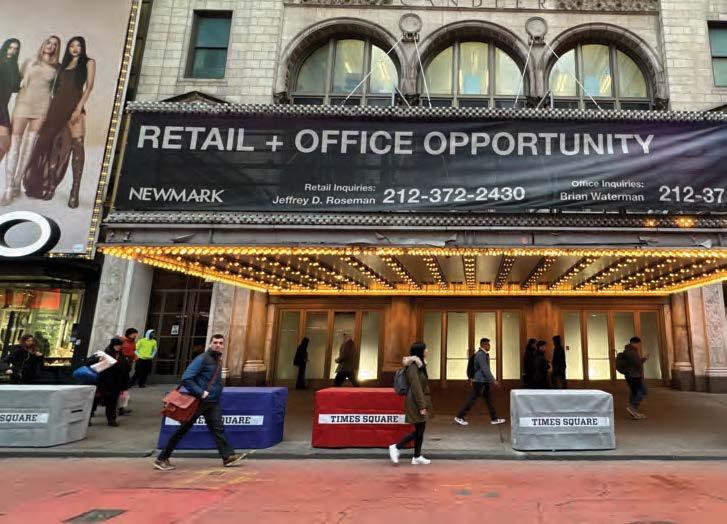
Some of those hosts may have gone legit: e number of alternative 30-day-plus listings jumped from 25,808 to 38,285 from August to September. But the 48% bump suggests that not all hosts changed their approach, meaning thousands of accommodations seemingly vanished overnight. And even the long-term listings are declining: ere were 37,302 in March, according to AirDNA.
from February: “Travelers will still require accommodations, and short-term supply is expected to decline signi cantly.”
Manhattan enclaves in New Jersey such as Weehawken, Union City and Jersey City saw huge increases in bookings.
It all adds up to the fact that the hotel industry, which pushed for Local Law 18 alongside prohousing groups, could enjoy a hefty $380 million windfall resulting from the smaller supply of rooms available through other options, according to a JLL report
Yet some critics think the kind of budget-minded travelers who used Airbnbs can’t a ord a lot of the current o erings, which skew toward luxury properties, and head to much-lower-cost lodgings in New Jersey or on Long Island instead.
And there is evidence to support that. As soon as Local Law 18 kicked into gear in September, short-term rentals in close-to-
Thursday, May 16 | 11:30AM - 5:30PM New York, NY
In August 2023, Jersey City experienced a 19% boost year over year. But a month later, its business soared 56%, AirDNA said. And most months since have continued to post double-digit gains over year-ago gures.
In any event, some hotel owners say it remains an open question if the Airbnb crowd is now wheeling their luggage into hotels instead.
“Low-budget tourists used to stay in hostels, and then they stayed in Airbnbs, but where will they go now?” asked Vijay Dandapani, the president and CEO of the Hotel Association of New York City. “ ey may go elsewhere or not come here at all.”
It’s not just the crackdown on Airbnbs that has removed options from the market, driving up room rates. e other major factor sapping supply is the use of lodgings
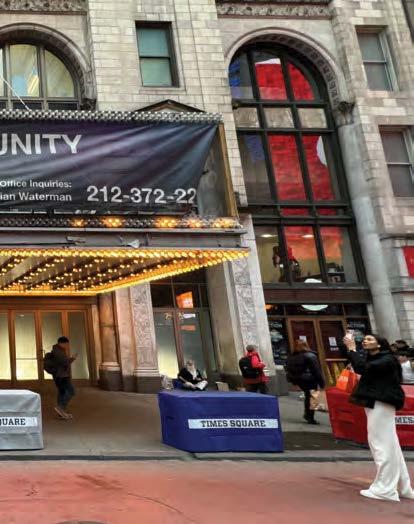
for migrant housing. Of the city’s 121,000 hotel rooms, about 16,000 of them, spread among 140 hotels, are currently housing migrants or the homeless and not available to travelers, according to November research from the data service CoStar.
at 13% of rooms that are now o limits include those at large and small properties, luxury and budget versions, and addresses in all ve boroughs, CoStar said. ey range from the Watson Hotel, a 600-room property at 440 W. 57th St. in Manhattan, to a Holiday Inn Express with 115 rooms at 625 Union St. in Gowanus, to an Essence hotel with 35 beds at 481 Hyland Boulevard on Staten Island.
Some 33 properties, about a quarter of the total, are expected to stay permanently closed to travelers. e majority are expected to reopen once their contracts with the city expire, which in some cases could happen within weeks.
And those reopenings, which would likely happen only after renovations, could ood the market with thousands of units. Midtown’s Roosevelt Hotel, at 45 E. 45th St., for instance, has more than 1,000 rooms.
Developer Yellowstone Real Estate Investments, which owns or holds a stake in several hotels turned shelters—Yellowstone controls the Watson, for instance— already has plans to reintroduce some properties.
First up could be a 265-room offering at 220 W. 42nd St., a Times Square o ce building that has been housing more than 1,000 migrants. It is in the process of being converted into a hotel, according to Yellowstone CEO Isaac Hera.
Another property the rm is working to revive, Hera added, is Midtown’s 700-room former Maxwell Hotel at 541 Lexington Ave., which has been dark since the start of the pandemic.
As it is, migrant-serving hotels might soon see less demand anyway. ough the city had as of February received about 180,000 migrants in two years, the ow across the Southern border, the entry point for many of them, seems to have abated in recent weeks.
In March Mayor Eric Adams reached an agreement limiting

most adult migrants to a single 30day stay in shelters, a deal reached with homeless rights advocates after months of negotiations.
Signs pointing up
e city had 51 million domestic visitors in 2023, a nearly 8% increase over 2022, according to the city’s o cial tourism arm. Global travelers, who had been slow to return to New York, paid almost 11 million visits last year, a 15% bump.
“We’re on track for 64 million visits in 2024, and we expect that total to grow even greater next year,” said William Fowler, a spokesman for Mayor Eric Adams, in an email. ”
Hotel occupancy rates have climbed in tandem. After notching an anemic 47% in the pandemic year of 2020, according to the hotel alliance, the rate hit 82% in 2023.
“Low-budget tourists used to stay in hostels, and then they stayed in Airbnbs, but where will they go now?”
Vijay Dandapani, the president and CEO of the Hotel Association of New York City
Room rates have been up as well. Manhattan’s revenue per available room, a widely used metric, grew to $245 in 2023, well above 2020’s $71 rate, the alliance said, though in ation is swelling the numbers.
And developers seem eager to pay top dollar for attractive sites.
At the end of last year, proli c hotel developer Sam Chang, for one, unloaded three Midtown Manhattan properties at a considerable pro t. e sites, at 16 E. 39th St., 292 Fifth Ave. and 25 W. 51st St., traded for a total of $207 million, nabbing Chang a more than $40 million gain, records show.
Similarly, Apollo Global Management and Newbond Holdings in the fall acquired the Renaissance New York Times Square Hotel from its developer, Sherwood Equities, for the blockbuster sum of $165 million, or more than a half-million dollars for each of its 317 rooms.
Seating a jury is simpler than nding new tenants at 40 Wall Street, the Donald Trump-owned building a 20-minute walk from the courthouse where the former president has spent much of his time recently.
But the buying boom has also extended to much smaller properties, including some with rocky pasts, such as a modest 10-story inn at 38-60 13th St. in the Dutch Kills section of Long Island City called the Giorgio.
Soon after the Giorgio’s developers opened the site in 2018, they began shopping it for $17 million. But the property, which catered to international students, emptied out with the onset of the pandemic, which depressed its value to $13 million, according to Besen’s Cohen, who marketed the site with partners Anudeep Gosal and Niko Berdzeni. A foreclosure threat from a lender followed.
Around the same time, landlords James Juhn and George Baharestani, like owners of other suddenly vacant hotels, opened their doors to migrants, a lucrative move. e city pays up to $340 a night for some properties, nearly double the typical shelter rate, Comptroller Brad Lander has said.
Although migrants can be controversial, they may be great for business. e 100% occupancy at strong prices can boost a property’s value; the Giorgio sold last year for its prepandemic valuation of $17 million, according to the city register.
“It’s a good time for hotel owners in New York,” said Mitchell Hochberg, president of the rm Lightstone, the developer behind 2,000-room Moxy chain, whose rst branch, on West 36th Street, opened in 2017.
But challenges remain. International travel is 10% below preCovid levels, much of that attributable to a dearth of visitors from China, he said. And corporate travel is down a similar amount from 2019.
Still, Hochberg’s hotels seem to be popular with a new kind of visitor, one who comes for business but tacks on a few extra days for leisure.
In any case, his portfolio’s rooms now have an average occupancy rate in the low 90% range, up 8 percentage points in a year, said Hochberg. “I’m not sure if the market is being arti cially boosted,” he said, “but I do think the table is being reset.”
struggle with elevated vacancy rates — the average is 25%, according to CoStar — but Attorney General Letitia James’s fraud suit showed 40 Wall’s nancial problems began well before the pandemic.
Vacancies have risen to 21% at 40 Wall St., a landmarked 71-story building and supertall for its era when constructed in 1930. e three-percentage point increase since last August, Fitch Ratings said in a report this month, is due to Duane Reade closing a 20,000 square-foot store in a former bank lobby featuring graceful limestone arches and black marble balustrades.
e retailer also terminated its lease for 80,000 square feet of corporate o ce space upstairs. It isn’t clear when the lease was scheduled to expire. Duane Reade continues to pay its vacated store’s rent, Fitch said, and the lease continues until 2032. e owner of Duane Reade, Walgreens Boots Alliance, said the 40 Wall St. store was closed due to “unsustainable business performance and high operating costs.”
40 Wall St. was acquired by Trump in 1995, and the 1.2 million-square-foot tower is one of three Manhattan o ce buildings owned by the Trump Organization. e others are Trump Tower and a 30% share of 1290 Sixth Ave.
Tenants have been steadily leaving 40 Wall St. since in 2018, when its vacancy rate was just 6%, according to Fitch data.
Fitch said rental income for the building has fallen by approximately 43% since 2015, when Trump re nanced the mortgage with the help of Jack Weisselberg, a loan originator at niche lender Ladder Capital and son of longtime Trump Organization CFO Allen Weisselberg. Many older buildings in the Financial District
In 2011, when the building produced negative cash ow for Trump Organization, court records show Allen Weisselberg directed an employee in accounting to prepare a document showing $26.2 million in net operating income. e building actually ran annual de cits as high as $20.9 through 2015.
‘Implausible assumptions’
e document directed by Weisselberg contained “a series of implausible assumptions,” state Judge Arthur Engoron wrote in his ruling in which he ordered Trump to pay $354 million in penalties for fraud, since raised to $454 million. Trump has secured a bond so he doesn’t have to come up with the money while appealing, but James contested the bond’s validity but the dispute was resolved at a hearing April 22 in the state courthouse at 60 Centre St. at’s the same day the former president’s criminal trial began in a di erent courthouse at 100 Centre St.
James has threatened to seize and sell 40 Wall St. if Trump doesn’t pay.
“We are prepared to make sure that the judgment is paid to New Yorkers,” she told ABC News in February, “and, yes, I look at 40 Wall Street each and every day.”
40 Wall St. is an undeniably attractive building whose pyramidal crown was the symbol of the original tenant, Bank of Manhattan Co. But it probably wouldn’t be highly valued by rival landlords. Fitch said the average inplace rent is just $40 per square foot, compared to a market/ neighborhood average of $55.












START YOUR NOMINATION AT
CrainsNewYork.com/40Nominate
Nominations due May 31
Notice of Formation of 11 LEONARD STREET LLC
Arts. of Org. filed with Secy. of State of NY (SSNY) on 04/10/24. Office location: NY County. SSNY designated as agent of LLC upon whom process against it may be served. SSNY shall mail process to Corporation Service Co., 80 State St., Albany, NY 12207-2543. Purpose: Any lawful activity.
Notice of Formation of
144 BROADWAY MEZZ
INVESTORS, L.P.
Cert. of LP filed with Secy. of State of NY (SSNY) on 03/25/24. Office location: NY County. Princ. office of LP: 41 Madison Ave., Ste. 3122, NY, NY 10010. Latest date on which the LP may dissolve is 12/31/2124. SSNY designated as agent of LP upon whom process against it may be served. SSNY shall mail process to Corporation Service Co., 80 State St., Albany, NY 12207-2543. Name and addr. of each general partner are available from SSNY.
Purpose: Any lawful activity.
Notice of Formation of ENFYS LLC. Arts of Org filed with Secy of State of NY (SSNY) on 1/30/24.
Office Location: NY County. SSNY designated as agent upon whom process may be served against LLC to: The Limited Liability Co., 228 Park Ave #141700, NY, NY 10003. R/A:United States Corp. Agents Inc.., 7014 13th Ave, Ste 202 Brooklyn, NY, 11228, USA. Purpose: any lawful act.
Notice of Formation of SHUO PHOTOGRAPHY LLC
Arts of Org filed with Secy. of State of NY (SSNY) on 3/18/24. Office Loc: NY County. SSNY designated as agent upon whom process may be served and shall mail copy of process against to 310 W. 56 Street, 6D, NY, NY 10019-5406 USA, shuo@shuo.photography
Purpose: any lawful act
Notice of Qualification of NYMI 2110 LLC
Appl. for Auth. filed with Secy. of State of NY (SSNY) on 04/11/24.
Office location: NY County. LLC formed in Delaware (DE) on 11/05/14. Princ. office of LLC: c/o LaSeven, Inc., 21 W. 58th St., Ste. 100, NY, NY 10019. SSNY designated as agent of LLC upon whom process against it may be served. SSNY shall mail process to Corporation Service Co. (CSC), 80 State St., Albany, NY 122072543. DE addr. of LLC: CSC, 251 Little Falls Dr., Wilmington, DE 19808. Cert. of Form. filed with DE Secy. of State, 401 Federal St., #4, Dover, DE 19901. Purpose: Any lawful activity.
Notice of Qualification of FOUR TREES STUDENT
HOUSING LLC Appl. for Auth. filed with Secy. of State of NY (SSNY) on 03/29/24. Office location: NY County. LLC formed in Delaware (DE) on 02/28/24. Princ. office of LLC: 28 Liberty St., 44th Fl., NY, NY 10005. SSNY designated as agent of LLC upon whom process against it may be served. SSNY shall mail process to Corporation Service Co., 80 State St., Albany, NY 12207-2543. DE addr. of LLC: 251 Little Falls Dr., Wilmington, DE 19808. Cert. of Form. filed with Jeffrey W. Bullock, 401 Federal St., Ste. 4, Dover, DE 19901. Purpose: Student housing investment management
Notice of Qualification of
IV-G
(OVERAGE) L.P. Appl. for Auth. filed with Secy. of State of NY (SSNY) on 01/04/24. Office location: NY County. LP formed in Cayman Islands (C.I.) on 11/30/23.
Duration of LP is Perpetual. SSNY designated as agent of LP upon whom process against it may be served. SSNY shall mail process to c/o Corporation Service Co., 80 State St., Albany, NY 12207-2543.
Name and addr. of each general partner are available from SSNY.
C.I. addr. of LP: Maples Corporate Services Limited, PO Box 309, Ugland House, Grand Cayman, C.I. KY1-1104. Cert. of LP filed with Registrar of Exempted Limited Partnerships of the C.I., Ground Fl., Government Admin. Bldg., 133 Elgin Ave., George Town, Grand Cayman, C.I. KY1-9000. Purpose: Any lawful activity.
Notice of Formation of OMR Ventures LLC. Arts. of Org. filed with NY Dept. of State on 2/5/24. Office location: New York County. NY Sec. of State designated agent of the LLC upon whom process against it may be served, and shall mail process to the LLC, c/o Aidala Bertuna & Kamins PC, 546 Fifth Ave, 6th Fl, New York, NY 10036.
Purpose: any lawful activity
PHASE III NYC LLC filed Arts. of Org. with the Sect'y of State of NY (SSNY) on 2/22/2024. Office: New York County. SSNY has been designated as agent of the LLC upon whom process against it may be served and shall mail process to: John Benis, 179 Christopher St, NY, NY 10014. Purpose: any lawful act.
Notice of Qualification of REDA CLASSON LLC
Appl. for Auth. filed with Secy. of State of NY (SSNY) on 03/15/24. Office location: NY County. LLC formed in Delaware (DE) on 03/14/24. SSNY designated as agent of LLC upon whom process against it may be served. SSNY shall mail process to Corporation Service Co., 80 State St., Albany, NY 12207-2543. DE addr. of LLC: 251 Little Falls Dr., Wilmington, DE 19808. Cert. of Form. filed with DE Secy. of State, John G. Townsend Bldg., 401 Federal St. - Ste. 4, Dover, DE 19901.
Purpose: Any lawful activity.
Notice of Formation of JadeM property LLC
Arts. of Org. filed with Secy. of State of NY (SSNY) on 03/27/24.
Office location: NY County. SSNY designated as agent of LLC upon whom process against it may be served. SSNY shall mail process to Corporation Service Co., 80 State St., Albany, NY 12207-2543.
Purpose: Any lawful activity.
Notice of Qualification of HANWHA FUTUREPROOF VENTURES LLC Appl. for Auth. filed with Secy. of State of NY (SSNY) on 03/12/24. Office location: NY County. LLC formed in Delaware (DE) on 03/06/24.
Princ. office of LLC: 280 Park Ave., 23rd Fl., East Tower, NY, NY 10017. SSNY designated as agent of LLC upon whom process against it may be served. SSNY shall mail process to Corporation Service Co. (CSC), 80 State St., Albany, NY 12207-2543. DE addr. of LLC: c/o CSC, 251 Little Falls Dr., Wilmington, DE 19808. Cert. of Form. filed with Secy. of State of the State of DE, 401 Federal St., #4, Dover, DE 19901. Purpose: Venture capital investment.
Notice of Formation of 38 BAT LLC Arts of Org filed with Secy of State of NY (SSNY) on 2/20/24. Office Location: NY County. SSNY designated as agent upon whom process may be served against LLC to: 250 W 81st St, #4B, NY, NY 10022
Purpose: any lawful act.
Notice of Formation of Business of Trouble LLC
Arts. of Org. filed with Secy. of State of NY (SSNY) on 03/28/24. Office location: NY County. SSNY designated as agent of LLC upon whom process against it may be served. SSNY shall mail process to; Shine Global, 350 W. 42nd St, 33B, New York, NY 10036. Purpose: Any lawful activity.
HOSPITALITY TECH
CONSULTANTS, LLC Arts of Org filed with Secy of State of NY (SSNY) on 3/3/24. Office Location: NY County. SSNY designated as agent upon whom process may be served against LLC to: 88 GREENWICH ST, APT 814, NY, NY, 10006, USA, Bryan.Z.Siegel@icloud.com. Purpose: any lawful act.
Notice of Qualification of ChargeTab Acquisition LLC
Appl. for Auth. filed with Secy. of State of NY (SSNY) on 04/18/24.
Office location: NY County. LLC formed in Delaware (DE) on 04/09/24. Princ. office of LLC: 101 Ave. of the Americas, 9th Fl., NY, NY 10013. SSNY designated as agent of LLC upon whom process against it may be served. SSNY shall mail process to the LLC at the princ. office of the LLC. DE addr. of LLC: Corporation Service Co., 251 Little Falls Dr., Wilmington, DE 19808. Cert. of Form. filed with DE Secy. of State, Div. of Corps., John G. Townsend Bldg., 401 Federal St., Dover, DE 19901. Purpose: Any lawful activity.
Notice of Qualification of GLOBAL PLASTICS, LLC Appl. for Auth. filed with Secy. of State of NY (SSNY) on 03/14/24. Office location: NY County. LLC formed in Delaware (DE) on 09/24/12. NYS fictitious name: MGI/GLOBAL PLASTICS, LLC. SSNY designated as agent of LLC upon whom process against it may be served. SSNY shall mail process to Corporation Service Co., 80 State St., Albany, NY 12207-2543. DE addr. of LLC: Cogency Global Inc., 850 New Burton Rd., Ste. 201, Dover, DE 19904. Cert. of Form. filed with Secy. of State, 401 Federal St., Ste. 4, Dover, DE 19901. Purpose: Any lawful activity.
Vice President, Portfolio Management (WorldQuant, LLC / New York, NY) –Devlp systematic strategies to exploit statistclly-dervd predictive signals (alphas) associatd w/ mrkt inefficiencies; devlp machine learng based predictive models to predict short term change of securities prices. Reqs Bach or higher in Electrical Engnrng, Math, Comp Sci, Comp Engnrng, Physics, Stats, or Operations Research or closly relatd field & 2 yrs exp in job offerd or as Regional Research Director, VP, Research, Sr Quant Researcher, &/or Quant Researcher, or in similar roles in financial quant research. Bkgrd in traing, educ, or exp must incld high perfrmnce softwre programng, incldg C or C++; exp devlpng predictive mrkt signals & optimization algorithms; mathematcl expertise, incldg undrstndng of analysis, linear algebra, logic, probablty & stats, & basic optimization concepts; exp handling computationally intensive large datasets; exp applying machine learng models in the movmnt of equities prices. Salary $150k to $200k per yr. Send resumes to Sandra.DiCairano@worldquant.com; ref job title in subjct line.
Bright Power, Inc. seeks Manager, Sustainability Services in New York, NY. Req. MS in sustainability stud, civ eng or related + 2 yrs exp. Salary $118,664/yr. CV to rkaumudi@brightpower.com
Wildlife Conservation Society (WCS) Request for Proposals Queens Zoo – Aviary plumbing infrastructure, ponds, and pedestrian walkway renovation Proposal Due Date: June 4, 2024
(Electronic submission to bids@wcs.org). Pre-Bid Conference Site Visit (In Person): May 13, 2024 at 9:00am. The project is funded by the City of New York through its Department of Parks and Recreation and is subject to certain NYC requirements And WCS policies. For a copy of the RFP please email bids@wcs.org.
NOTICE OF FORMATION of Duffy + Boyd LLC. Arts of Org filed with Secy. of State of NY (SSNY) on 2/9/23. Office location: NY County. SSNY designated as agent upon whom process may be served and shall mail copy of process against LLC to 4 44 E 88th St, Apt 3E, New York, NY 10128.
Purpose: any lawful act.
Notice of Formation of LEXVIEW PROPERTIES LLC
Arts. of Org. filed with Secy. of State of NY (SSNY) on 03/15/24. Office location: NY County. SSNY designated as agent of LLC upon whom process against it may be served. SSNY shall mail process to Corporation Service Co., 80 State St., Albany, NY 12207-2543. Purpose: Any lawful activity.
Notice of Qualification of IBI ICELAND LLC
Appl. for Auth. filed with Secy. of State of NY (SSNY) on 03/21/24.
Office location: NY County. LLC formed in Delaware (DE) on 03/01/24. SSNY designated as agent of LLC upon whom process against it may be served. SSNY shall mail process to the LLC, 450 W. 14th St., NY, NY 10014.
DE addr. of LLC: c/o Corporation Service Co., 251 Little Falls Dr., Wilmington, DE 19808. Cert. of Form. filed with DE Secy. of State, John G. Townsend Bldg., 401 Federal St., Ste. #4, Dover, DE 19901.
Purpose: Any lawful activity.
Notice of Qualification of FOUR TREES CAPITAL MANAGEMENT LLC Appl. for Auth. filed with Secy. of State of NY (SSNY) on 03/21/24. Office location: NY County. LLC formed in Delaware (DE) on 02/28/24. NYS fictitious name: FOUR TREES CAPITAL MANAGEMENT NEW YORK LLC. SSNY designated as agent of LLC upon whom process against it may be served. SSNY shall mail process to Corporation Service Co., 80 State St., Albany, NY 12207-2543. DE addr. of LLC: 251 Little Falls Dr., Wilmington, DE 19808. Cert. of Form. filed with Jeffrey W. Bullock, 401 Federal St., Ste. 4, Dover, DE 19901.
Purpose: Any lawful activity.
Notice of Formation of H-MAP LLC Arts. of Org. filed with Secy. of State of NY (SSNY) on 04/11/24. Office location: NY County. SSNY designated as agent of LLC upon whom process against it may be served. SSNY shall mail process to c/o Kevin Ryan, 270 Bowery, NY, NY 10012. Purpose: Any lawful activity.
Notice of Qualification of CRYSTAL SCREENS MEDIA LLC Appl. for Auth. filed with Secy. of State of NY (SSNY) on 04/17/24. Office location: NY County. LLC formed in Delaware (DE) on 01/27/06. Princ. office of LLC: 125 W. 55th St., Level 23, NY, NY 10029. SSNY designated as agent of LLC upon whom process against it may be served. SSNY shall mail process to Corporation Service Co. (CSC), 80 State St., Albany, NY 12207-2543. DE addr. of LLC: CSC, 251 Little Falls Dr., Wilmington, DE 19808. Cert. of Form. filed with DE Secy. of State, Div. of Corps., John G. Townsend Bldg., 401 Federal St., Dover, DE 19901. Purpose: Any lawful activity
Notice of Qualification of TOPPAN DIGITAL LANGUAGE (AMERICAS) LLC
Appl. for Auth. filed with Secy. of State of NY (SSNY) on 03/18/24. Office location: NY County. LLC formed in Illinois (IL) on 12/08/16.
Princ. office of LLC: 1325 6th Ave., 33rd Fl., NY, NY 10019. SSNY designated as agent of LLC upon whom process against it may be served. SSNY shall mail process to Corporation Service Co., 80 State St., Albany, NY 12207-2543. Cert. of Form. filed with Secy. of State,
Notice of Formation of TORREY ART, LLC
Arts. of Org. filed with Secy. of State of NY (SSNY) on 03/22/24.
Princ.
2105,
10155. SSNY designated as agent of LLC upon whom process against it may be served. SSNY shall mail process to
Torrey LLC at the princ.
housing construction, a version of “good cause” eviction protections, raising New York City’s cap on residential density, allowing bigger rent hikes for landlords who renovate stabilized apartments and incentivizing more o ce-toresidential conversions.
e new tax break, known as 485-x, provides tax relief for projects where a ordable units are rented at an average of 80% of the area median income — with large buildings required to have at least 25% a ordable units versus 20% for smaller buildings. An agreement between the real estate industry and labor unions set a minimum wage of $72.45 an hour for construction workers on buildings in parts of Manhattan, western Brooklyn and western Queens.
construction will be exempt for 30 years, starting with buildings constructed in 2009.
e bill also includes a muchdiscussed carve-out for landlords who own fewer than 10 units. Although tenant advocates have called that provision unenforceable due to landlords’ often-hazy portfolio sizes, the bill states that landlords will be required to inform tenants on their leases whether they are eligible for good cause protections.
Both good cause and the 485-x tax break are scheduled to expire in June 2034, setting the stage for another housing battle in a decade. Tenant advocates have lamented the numerous carveouts to good cause, although it could still bring new protections to some half a million apartments, by some estimates.
Another much-discussed program to create a pilot for legal basement apartments in New York City is included in the budget — but, in a compromise, will only apply in a few neighborhoods to be chosen by the City Council from a list of about a dozen community districts.
James Whelan, president of the Real Estate Board of New York, predicted that the new tax break [485-x] “will produce less rental housing than its predecessor, 421-a.”
Labor unions welcomed the new program, but the real estate industry’s response was muted. James Whelan, president of the Real Estate Board of New York, predicted that the new tax break “will produce less rental housing than its predecessor, 421-a.”
e completion deadline for projects to bene t from the lapsed 421-a program has been extended to 2031, but only for developers who choose one of the deeper a ordability schemes.
e good cause eviction law will give tenants the right to dispute rent increases above 10%, or 5% plus the rate of in ation, whichever is less. It applies only in New York City, with other localities having the ability to opt-in to the program and make certain changes if they wish.
Good cause will not apply to units renting above 245% of fair-market rent — equivalent to $5,800 for a studio — or all rentstabilized and income-restricted housing or owner-occupied buildings with 10 units or fewer. New
And the budget will indeed lift New York City’s longstanding cap on oor-area ratio, paving the way for denser apartment buildings — but states that the new buildings must be subject to a ordability minimums like mandatory inclusionary housing. e lifted cap will also not apply in historic districts.
Budget documents spell out a deal to prevent the closure of SUNY Downstate’s University Hospital. e deal between lawmakers and the Hochul administration will halt the closure of the East Flatbush teaching hospital while o cials appoint an advisory commission to examine the facility’s services and nancial status, which will have a year to produce recommendations about the hospital’s future.
e state will provide $100 million in operating aid for Downstate while the commission makes recommendations on how to spend at least $300 million in capital funds in the coming years.
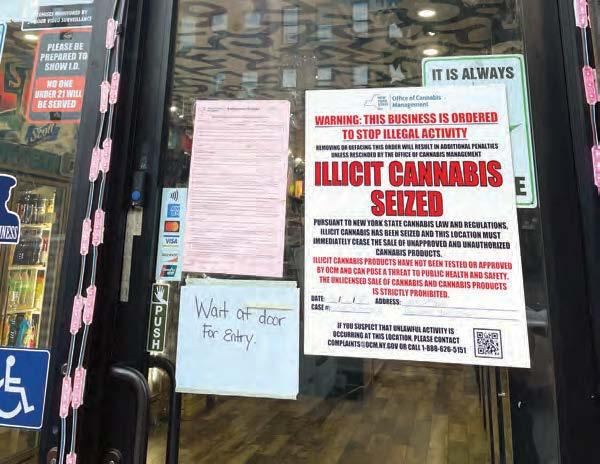
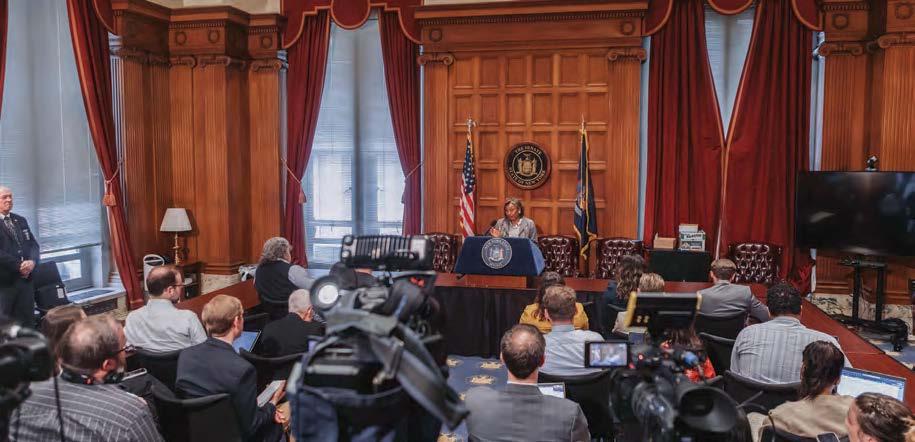
e health budget also reverses most of Hochul’s proposed $1.2 billion cuts to the Medicaid program, restoring up to $825 million for health care facilities. Hospitals will get a total of $525 million in Medicaid payment increases, while nursing homes will receive $285 million and assisted living facilities will receive $15 million.
Unlike last year, this year’s budget authorizes sums of money instead of annual, across-the-board Medicaid rate hikes. Details on Medicaid payment increases to hospitals and nursing homes could change because they hinge on a state plan to tax health plans and bring in billions of federal dollars for health care. e budget directs state o cials to submit an application to the federal government to tax managed care organizations, a type of health insurer, but wasn’t clear how much revenue the tax would generate or when it would be available to funnel back to health care facilities. Legislators initially estimated that the tax could generate $4 billion a year, but the total will likely be less than that.
Hochul did uphold her budget promise to cut administrative spending in the consumer-directed personal assistance program, a $9 billion home care program that allows New Yorkers to hire family members or friends as caregivers. New York will appoint a single entity to manage payroll and administrative tasks for the 250,000 people who participate in the program statewide — a reduction from the 700 organizations that do that job currently. Hochul said that the move could save the state up to $500 million a year.
e budget includes Sammy’s Law, a policy long sought by safestreets advocates that would empower New York City to set its own speed limits below the state minimum of 25 miles per hour.
e bill had faltered in several prior years amid opposition in the Assembly from driver-heavy districts in the outer boroughs. is year’s breakthrough includes a compromise that would exempt roads with greater than three lanes of tra c.
For any changes to take effect, the City Council and Mayor Eric Adams would need to pass their own law lowering the city’s
speed limit.
e bill’s premise is based on research that shows people hit by cars moving below 25 miles per hour are less likely to die or be seriously injured. It is named after 12-year-old Sammy Cohen Eckstein, who was fatally struck by a van driver in Brooklyn in 2013 and whose family has pushed for the law.
Policymakers are taking a new crack at shuttering the illicit cannabis shops that have spread across New York City, undercutting the state’s legal weed market.
e budget will allow municipalities to seek emergency court orders to shutter the shops, heeding requests by Mayor Eric Adams and his Albany ally, Assemblywoman Jenifer Rajkumar.
Landlords in the city that fail to start eviction proceedings against an illicit shop within ve days of being noti ed could also be ned $50,000. And the budget empowers the state’s O ce of Cannabis Management to padlock businesses immediately after an inspection if they are found to be selling illicit products or peddling to minors.
“ e illegal shops will not disappear overnight. But New Yorkers eventually will see a change in their communities,” Hochul said at an April 19 press conference, where she held up a celebratory padlock alongside Mayor Adams.
In another partial victory for Mayor Adams, New York City will get $2.4 billion to cover the costs of caring for asylum-seekers — the same amount Hochul had pledged in her January executive budget, but less than the mayor had hoped for.
e new infusion will bring the state’s total commitment on migrant funding to $4.3 billion to date. ( e city has spent about the same amount, but the Adams administration projects another roughly $10 billion in costs through next year.)
e budget grants Adams an extension of his control over the city’s public school system for two years. Adams’ more ambitious request for a four-year extension was supported by Hochul but ap-
peared to die during budget talks, only to be revived at the last minute as a two-year extension.
As Senate Majority Leader Andrea Stewart-Cousins had previously indicated, the two-year extension comes with conditions, including more control by the state Legislature over an oversight panel.
e budget will include many of the anti-retail theft proposals that Hochul had sought, despite resistance from lawmakers wary of toughening criminal laws.
at includes elevating the penalty for assaulting a retail worker to a felony, although it will be a Class E charge — less serious than the Class D that Hochul had proposed.
e budget also includes $40 million to fund retail theftprevention e orts in the State Police, local prosecutors’ o ces and local law enforcement; and $5 million to create a $3,000 tax credit for small businesses that spend money on anti-shoplifting measures.
e provisions won praise from some local business leaders, including the Five Borough Jobs Campaign — a coalition that includes business improvement districts and chambers of commerce. Tom Grech and Randy Peers, leaders of the Brooklyn and Queens chambers, hailed the policies in a statement as “important steps.”
Hochul will largely get her wish to create a consortium focused on arti cial intelligence, centered at the University of Bu alo campus of the SUNY system. e budget includes $250 million for the socalled Empire AI consortium, intended to fund new buildings at the SUNY Bu alo campus.
Private entities have pledged their own funding, with other schools like Columbia and Cornell universities also expected to take part in the seven-institution consortium.
But the Legislature, concerned about oversight, won some concessions from the governor, Bloomberg reported. ey include requiring Empire AI to submit a governance plan within a year and send annual nancial reports to the state Senate and Assembly.
Caroline Spivack contributed reporting.

ADVERTISING
www.crainsnewyork.com/advertise
www.crainsnewyork.com/custom
www.crainsnewyork.com/events
More than 30 years ago Annika Pergament drove up the coast, starting in Florida, in search of her rst journalism job after graduate school—her trunk lled with tapes of herself as a news anchor. She landed a gig in television news just several hundred miles later.
“I hit every news station on the way. And by the time I got to South Carolina, I got a job,” she said.
It wasn’t the exact position she wanted, which would have been on the air, but it was a morning producer for the CBS a liate in Florence and Myrtle Beach. And it wasn’t long until a reporter quit and she got a seat in front of the camera.
“I think the immediacy of television journalism just really appealed to me,” she said.
Pergament, who attended high school in Switzerland and grew up speaking Swedish and French, says her interest in journalism started with taking photos when she was an undergrad at Duke University, where she snapped a couple of shots for the school newspaper. A history major, Pergament took a job as a paralegal for the summer at a New York law rm before graduation and considered attending law school. But
an attorney at the rm suggested she pursue a di erent career.
Pergament listened. After just ve months in South Carolina, she eventually landed a job in New York at NY1—then owned by Time Warner Cable—in 1994. Her rst day was Aug. 29.
“I know the date by heart because Aug. 30 is my birthday,” she said.
She started o covering state politics, dabbled in live trial coverage, for which she got to show o her legal knowledge, and then became the senior business anchor, regularly interviewing entrepreneurs, business owners and CEOs. Now, she hosts e Rush Hour which airs weekdays from 4 to 6 p.m.—interviewing some of New York’s most powerful players.
Pergament won an Emmy in 2022 for her segment “How Lower Manhattan Has Evolved Post 9/11,” which aired in 2021.
She has held a few local positions in New York over the years, including at WCBS, Court TV and at WPIX as a freelancer. During one of her many stints at NY1— and in between her cameos play-
ing herself on television series e Sopranos, Law & Order, Gossip Girl and Mr. Robot—Pergament took a continuing education program in business to help bolster her coverage of the industry. Her bosses soon moved her position from the newsroom down to the oor of the New York Stock Exchange—making NY1 the only local news station to be represented next to the iconic bell.
“It was a challenge, but it was de nitely time for me to learn something new,” she said. “And that really sort of piqued my interest in covering business news.”
Her experience as a business reporter has dovetailed with her position as the host of e Rush Hour, which launched this past January. Spectrum has more than 32 million customers across its 41-state service area.
Some of Pergament’s favorite and most prominent guests have included Bill Rudin of Rudin Management Co., former interim New York City Transit President Sarah Feinberg and civil rights attorney Ron Kuby.
“I have a stable of people who I bring on who are experts at sort of distilling complicated information,” she said. “I always love to
By | Julianne CubaAnnika Pergament took a continuing education program to help bolster her coverage of the business industry. She soon moved from the newsroom down to the New York Stock Exchange.
Age 55
Grew up North Salem, Westchester County Resides Westport, Connecticut
Education Bachelor’s in history, Duke University; master’s, Medill School of Journalism at Northwestern University
Family life Pergament is married, and she and her husband have two teenage sons, ages 17 and 19.
Off the air When she’s not in her anchor’s chair, Pergament loves to do yoga and watch television shows, including Succession and Drops of God, with her family.
Local fan She cheers for the Yankees, Knicks and Rangers.
CUSTOMER SERVICE
customerservice@crainsnewyork.com or (877) 824-9379
(212) 210-0707 or lmelesio@crain.com